

Alaska Moose Hunts
Professionally guided alaska moose hunts above the arctic circle, moose hunts.
Alaska moose hunting is the ultimate adventure. The sight of a mature animal raking its antlers only thirty yards away or hearing a 1500 pound bull crashing through the brush responding to your call is an unforgettable experience.
The Moose, Alces alces, is the largest member of the deer family, we hunt the Alaska-Yukon race, Alces alces gigas, largest of all the moose. Moose go into rut in mid-September, fighting to control groups of cows. During the rut, bulls become vulnerable and frenzied as they become focused on their love life and ruled by their hormones. During the rut, bull grunts and cow calls become extremely effective, sometimes bringing in a trophy sized moose from miles away. All of our guided moose hunts are conducted out of stationary, comfortable canvas tent camps. Although we use rafts to hunts nearby lake shores and sloughs, we do not offer guided float hunts. By staying away from the main river systems, we are able to provide remote trips where there is nearly no other hunting pressure. The result is a high success rate, bigger bulls harvested, and a more authentic experience for our guest.
Lake Hunting
We have several lake based moose camps that we hunt annually, from September 10-25. These hunts are 1 on 1 with the option of a non hunting companion to come along. This hunt is ideal for the hunter looking to take a trophy of a life time without doing a tough, pack style hunt. Each of our lake camps are placed in locations that allow us to glass the nearby lake shores during the early morning and evening hours.
As the September rut begins, moose congregate on our prime lakes. Here, bulls fight for space and to control their harem of cows. At times the larger bulls have as many as 6-10 cows herded up and are constantly fighting to keep other bulls from stealing their mates. We usually stay put until a desirable bull is found and he has moved into an approachable spot. Using rafts and inflatable canoes we put ourselves downwind of the targeted animal.
While out moose hunting, great care is taken so as to avoid spreading our scent around the lake. Calling both with bull grunts and cow moans can be very effective during the fall rut. On still, cold days, bulls can be heard challenging each other from miles away. We have perfected the art of persuading big bulls into a fight. Even a bull with a large harem of cows can be convinced to leave his mates to show up another bull across the lake. Other bulls are reluctant to leave their cows and we have to get up close and personal in order to challenge them.
Watching a 60”bull charging into your guides bull grunt is an experience that will never be forgotten. Because of the tall lake grass and generally more predictable nature of these moose, our lake camps are a good option for the archery hunter. Ambushing a large bull with nothing but a stick and sting in hand is a heart pounding experience!
We take a pair of moose hunters into our most remote camp every September. This hunt is a unique opportunity to hunt a migrating population of moose. We have selected a prime location dubbed the “Northern Camp” where moose funnel through the valley. This travel corridor becomes incredibly active when the temperatures drop and the bulls head south. This is the only moose camp where we will take a pair of moose hunters. We have enjoyed a high success and many phenomenal bulls taken out of the Northern Camp.
Although hunting from a stationary camp, access is more difficult than our lake camps and requires a higher degree of physical ability. Both Grizzly and caribou can be hunted from this camp. The Caribou migration patterns in this area are highly unpredictable, some seasons we see hundreds in the Northern Camp while other seasons there are none. Typically bears taken on our guided moose hunts are off moose gut piles. After harvesting a moose we let the gut pile sit undisturbed for several days. Both wolves and bears will often find the leftovers, providing an idea hunting opportunity.

Accommodations
Although there are many factors outside of our control during an Alaskan hunt, there are measures we take to insure a comfortable stay no matter what Mother Nature decides to throw at us. Camps are strategically placed to insure solid hunting locations within a close walking distance. As most of our falls hunting camps are accessed via float plane, we are typically set up on or near a lake shore. Guests are housed in canvas Sibly tents, heated with a wood stove and furnished with cots. A cook/mess tent is also set up to allow comfortable dining during adverse weather conditions. We take great efforts to prepare home cooked breakfasts and dinners that will satisfy any hungry hunter. While out hunting, lighter pack lunches are packed. All camps are supplied with at least one satellite communication device and appropriate survival gear.
Travel and Logistics
All of our guided trips originate in Fairbanks Alaska. We suggest booking a flight with an arrival date at least one day before the start date of your trip. There are several options of hotels near the airport that provide shuttle services. On day one of your trip we will pick you up at your hotel. If you have not already purchased your hunting license and tags, we will stop by Fish and Game before leaving town. From Fairbanks, we drive four hours north to Circle City. In this small rural community, your pilot will meet you with the float plane on the Yukon River. Most of our camps are accessed via float equipped Cessna 180. As we have to follow the strict laws of gravity, we ask that you keep your gear under 60lbs. Most flights to camp are an hour to an hour and a half. Due to the unpredictability of Alaska’s weather it is best to leave some flexibility in your travel plans. At times, delays of several days may occur due to severe weather keeping our airplanes grounded.

All of our guides are highly experienced and professional. Owner, Charlie Jagow, was raised hunting and trapping in the region, this experience has given him, not only knowledge of the area, but also a personal connection to the refuge and its wild places. Many of our hunting guides also live in the bush and have a life time’s experience worth of hunting in the Arctic. Hunting is a way of life for us. There are no schools or college courses available to train a guide; instead, this highly skilled profession is only learned from hands-on experience and apprenticeship. All of our guides have dedicated themselves to perfecting these skills. Guiding is not a job for us, it’s a passion. We love assisting our guest in the pursuit of a life time!
There are opportunities to fish in most of our hunting camps. Some of the smaller rivers provide some of the best grayling fishing the state has to offer. Many of our lake camps are inhabited by both pike and graying. Light tackle, spinners and spoons are our choice for catching both species.

2023 Schedule and Prices
Contact us today about joining one of our 2023 hunts.
Trophy fees on secondary animals taken:
- Grizzly Bear – $3,500 USD
- Caribou- $4,500 USD
- Wolf or Black Bear – $1,500 USD
Included in the hunt are bush flights to and from Fairbanks, camp gear, food, and one-on-one guiding. Not provided in the hunt is lodging in Fairbanks, hunting license, and tag fees.
- (218) 434-0068
- (907) 464-6165


Alaska Moose Hunt
We offer the only 15-day moose/brown bear combo hunt in our area allowing four more days to bag your trophy brown bear., comfortable base camps that have generators, wood heat, showers, out-house, and freezers., we utilize spike camps for hunting active bulls & bears., eight years in a row of favorable winters has helped trophy bull size & numbers., a finite amount of alaska moose hunt permits restricts hunting pressure., river hunting out of jet boats allows for smooth movement up and down the river and the ability to get back to those hard to reach area’s., floatplane into one of our six base camps., alaska non-resident hunting license and tags are available directly from alaska elite outfitters or adfg ., moose hunting references, alaska moose hunting.
Alaska Moose Hunt with Alaska Elite Outfitters is a fully guided top quality Moose Hunting experience. By taking a limited # of moose hunters into our vast area, we keep the Moose hunting quality high. Alaska Elite Outfitters efficiently use jet boats for hunting the Trophy Bull Moose in our area. Thus traveling from calling spot to calling spot is comfortable and practical. Cow calling, bull grunts, and brush thrashing are the primary methods of getting big bulls within gun & bow range.
Alaskan/Yukon Moose Hunting On Nushagak River
Generally, backwaters, small rivers, and meadows are where big trophy bulls hangout. Thereby our ability to travel on jet boats and Zodiacs makes it possible to access these big Alaskan Bulls. Including the use of “Spike Camps, Alaska Elite Outfitters provides you the best opportunities to hunt these giant bulls. Especially early morning and late evening is essential to be out hunting. However, we return to base camp mid-day to resupply and dry out for the next night’s hunt.
We moose hunt in early September (5th – 15th) during the pre-rut, when the bulls are very receptive to calling. We travel between call spots using a variety of calls and raking brush. Spot & Stalk methods are used in some circumstances when the terrain and brush are less dense. Understand these big bulls are not standing in the open like a photo in a magazine article. They’re here, and they’re big, but you have to work to get them. In conclusion, being patient is the most important thing; we can’t emphasize this enough.
Alaska Bull Moose Hunt ; Two-mile corridor Permit Area
The trophy moose hunting in our particular area is unique in that it is a corridor permit hunt. There is a two-mile corridor along the upper Nushagak river, Mulchatna River. Their tributaries receive a limited number of non-resident bull moose permits each year to restrict the number of bulls taken from this area. Having said this, we have never exceeded that # of licenses, and they have always been available for our hunters.
Trophy Alaska Moose Hunt
The reason our Alaska trophy Moose Hunts has done so well, and the average size of the bulls is increasing in recent years, is that we have experienced eight mild winters in a row. Thus, allowing the old breeding bulls enough time to recoup after the breeding season. Mild winter has not only increased those 64″-74″ bulls harvested, but there are just more of them in our area! The mild winters help get the older bulls healthy again and make it much harder for wolves to get the Moose caught in the deep snow, which allows the overall population to grow.

ALASKA ELITE OUTFITTERS CURRENT SPECIALS

Alaska Elite Outfitters Hunting Specials
fully guided moose hunts $32,500.
11-day Moose Hunts (Sept 5-15)
Fully Guided 15-day Combo hunts $44,500
15-day Moose/Brown Bear Combo (Sept 5-19)
Self Guided moose hunts $12,500
(Sept 5-15)
10-day (Unit 17) Brown Bear Hunt spring/fall $22,500
(May 10-20; May 21-31; Aug 20-30; Sept 16-26)
15-day (Unit 17) Brown Bear Hunt spring $30,000
(may 13-27), 10-day baited brown bear hunt, $20,000 | hunt, alaska elite outfitters fishing special, king salmon fishing, self guided $3500/pp fully guided $4500/pp.
(June 20 – 25; June; 25 – 30; June 30 – July 5)
SILVER SALMON FISHING
self guided $2750/pp fully guided $3500/pp.
(Aug 6-11 ; Aug 11-16; Aug ; Aug 16-21; Aug 21-26)
All Self-guided trips include lodging, food, bedding, shower facilities, rods/reels, freezers and use of all fish packaging supplies for fish transport.
Fully guided fishing trips include all the above with the addition of a guide, bait, lures, fish cleaning & packaging., new for 2024, 3-bedroom fishing lodge.
- fuel oil heat
- full kitchen
- dining room
- 2 bathrooms
- TV streaming service.
Email: [email protected] | ADFG | Phone: 218-434-0068 ; 907-464-6165 011
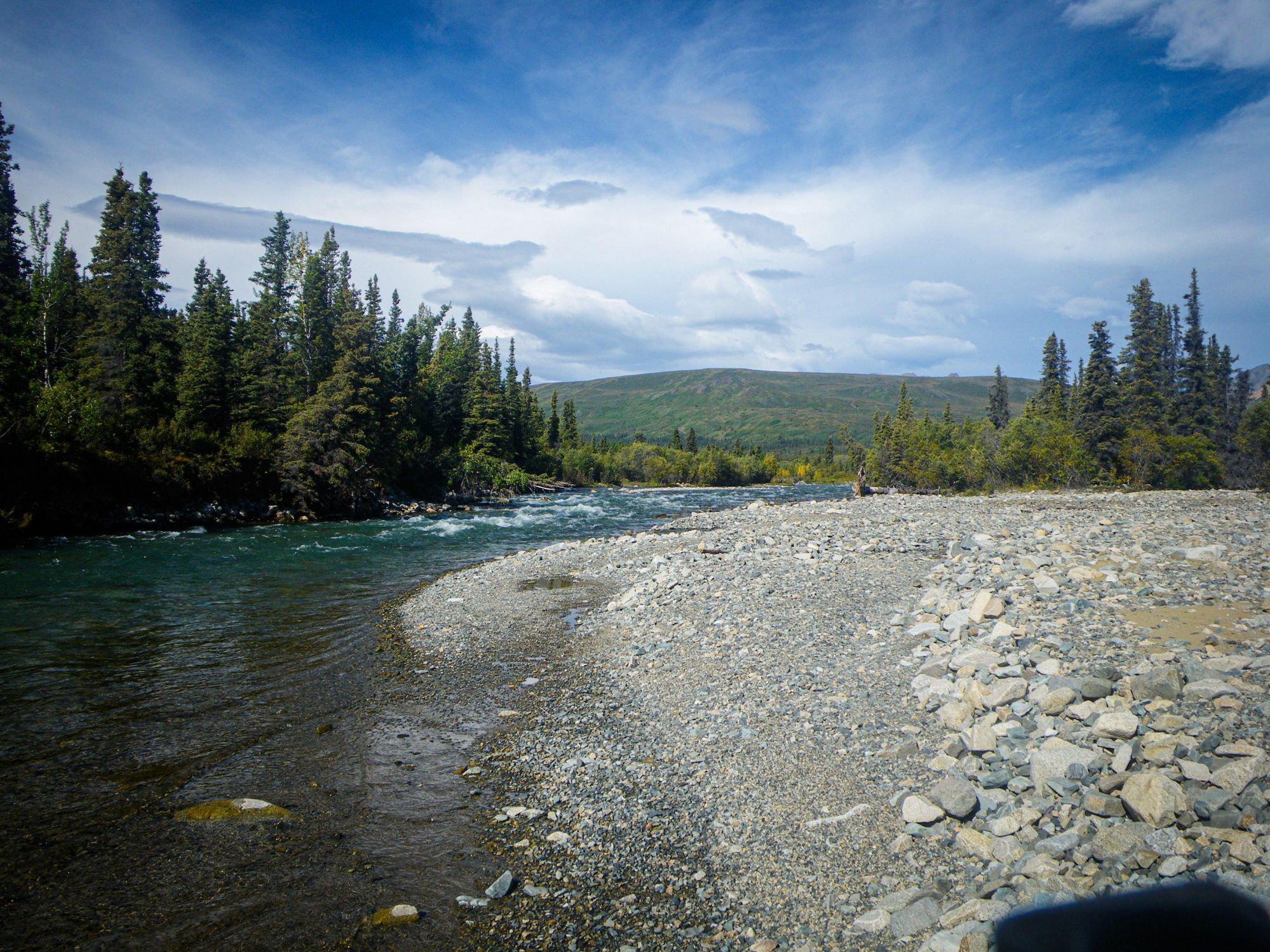
Alaska Moose Hunts
A truly remote moose hunting experience.
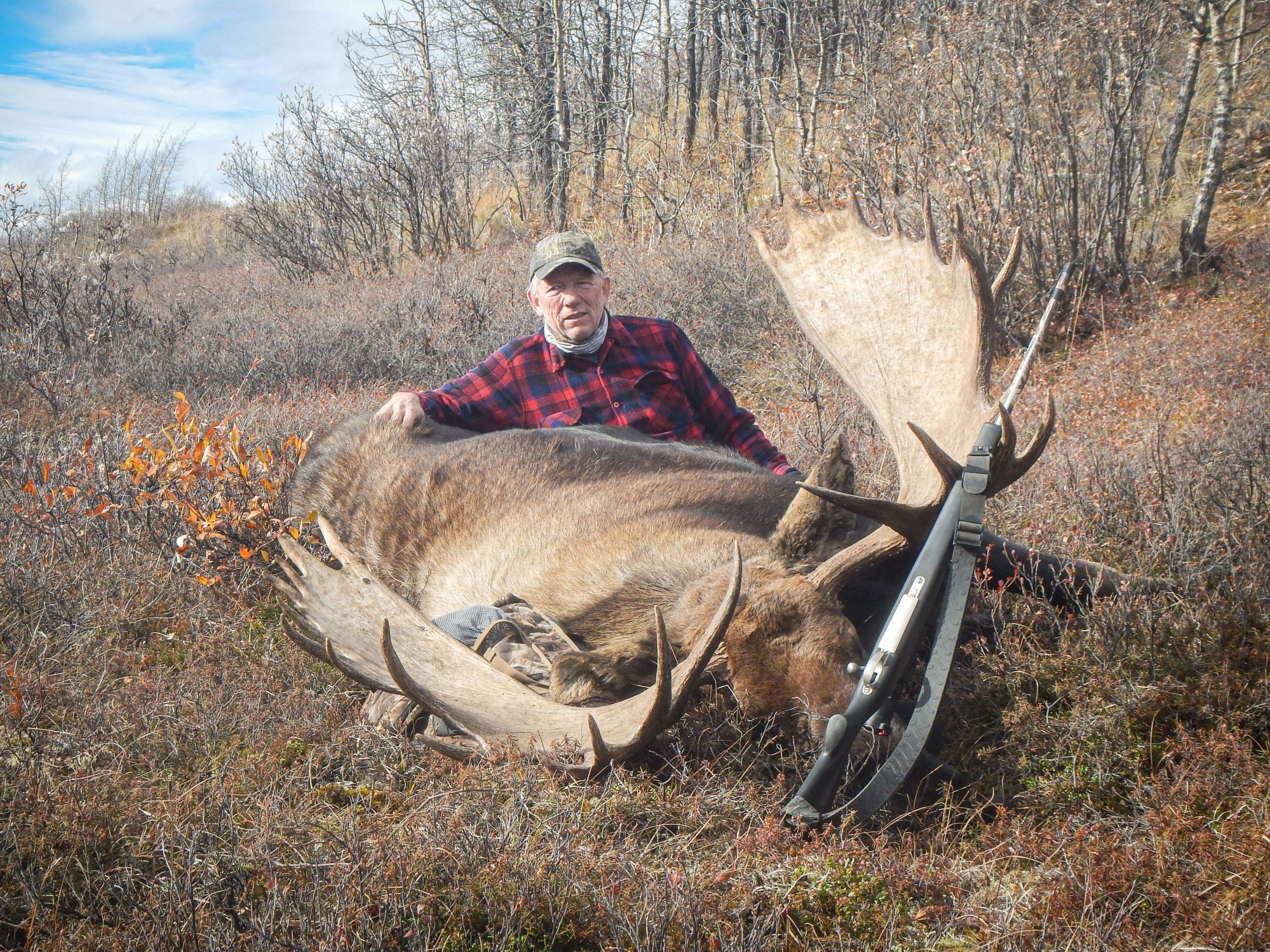
About Our Moose Hunts
High Quality Hunts With: Exclusive Area, Large Animals, Professional Guides, Home Cooked Meals, Beautiful Country. Our Alaska guided moose hunting trips is especially good because of our very limited harvest and the geographic location of the area. Guided moose hunting Alaska come from the flats where they have spent their summer and go up into the high country to rut. We hunt the passes on the edge of the high country and catch the bulls as they travel through. The guided moose hunts offered by Wrangell Outfitters are targeted toward the sportsman who wants a very classic and exclusive experience. The hunting area that we use is an exclusive federal Concession within the Wrangell, St. Elias National Park Preserve. Wrangell Outfitters is the only company that can contract hunts for this area. Horses are used to access the distant corners of the hunting area and help to create the nostalgic feel of the classic Alaskan Safari. Attention to detail results in excellent staff, equipment, and meals. Our horn size is consistently larger than the Alaskan average. Hunts are run on a 1 guide to 1 hunter ratio unless otherwise desired.
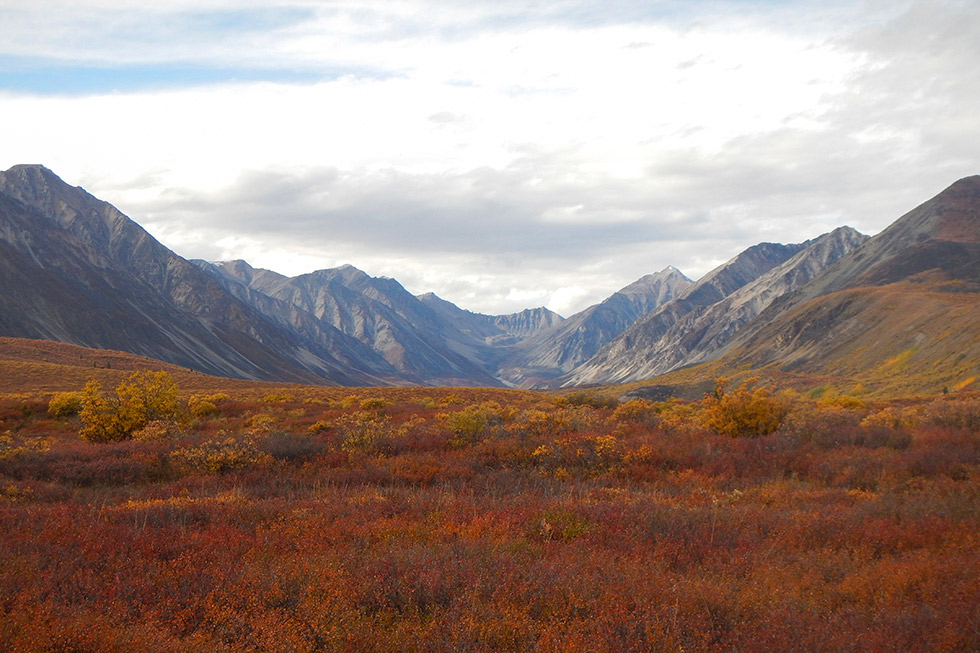
Alaskan Moose Hunting
Moose hunting faq's.
Some of the normal questions we get asked include:
What's your success rate?
Only 1 un-succesful moose hunter in 8 years (94 % since 2016)
How many moose do you harvest each year?
Just 2-5 moose hunters taken per year.
What style of hunting are your moose hunts?
Alpine hunting offering great visibility.
How large of an area do we cover?
358 square mile exclusive hunting concession within the Wrangell St Elias National Park Preserve.
what is your average antler width?
Our moose gallery.
A sample of our hunts
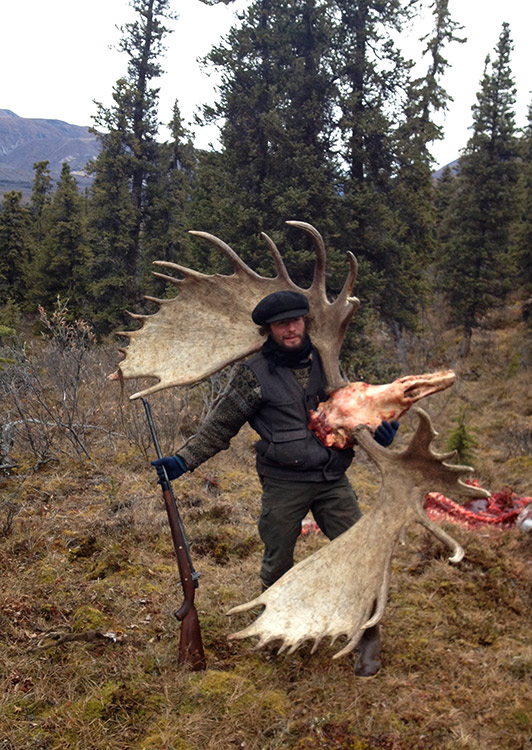

- Alaska Yukon Moose
- Snowmobile Tours
- Ice Fishing
- Dog Sledding
- Snowmachine Rental

Guided Moose Hunts in Alaska
My 2019 moose season was a great one with lots of moose rutting activity. Above friends Corey and Deric, Aaron (packer), and I pose with their 60” bull that was called to us as the sun set on day 3 of their hunt. Our second bull was harvested on day 7 of the hunt.
I offer one guided moose hunt in Alaska with two hunters per year. When you inquire about this hunt, I answer your questions and I will be your guide.
Your hunt takes place on a tributary of the famous Yukon River in the heart of Interior Alaska. This Yukon River moose hunt is conducted during the rut when moose are very active and responsive to calling. We have seen up to 11 moose at one time with multiple bulls well over the 60 inch range mixed with cows and younger bulls on a hillside. Our harvested moose antler spread averages 55 to 65 inches. We target large trophy bulls. My hunting area has an antler restriction for moose harvested by non residents of: 50" antler spread or 4 brow tines on one side.
Moose Camp/Hunt:
I use small bush planes, from experienced transporters, for transportation out of my hunting area. I use specially designed hunting rafts as our mode of transportation during the hunt. We paddle down the river to prime hunting areas. These prime areas are back channels off the main river, marshy swamps, and mountain sides. From these spots we use proven moose calling techniques to bring the bulls to us. We typically spend 3 days at each hunting location. A moose will come to a call--it may be in 10 minutes--it may be in three days; but he will come to investigate the call.
This hunt is ideal for archery and rifle hunters. We typically harvest moose with-in 50 yards. I do recommend that all archery hunters also bring a rifle as a back up. There is times when an archery shot is just not possible on the bull of a lifetime.
My camp consists of top of the line tents and a cooking/eating shelter. Two hunters share a 6-man tent with cots. The tents are tall enough to stand up in.
A typical day at moose camp:
Rise at 5:30 AM for coffee and a light breakfast. We call for moose around daylight. As the sun rises we move to vantage points to watch and listen for moose responding to the call. Many times we will have moose near camp that responded to calling the night before. We usually eat a hearty brunch after the morning hunt. After brunch we head out to call during midday to "prime the area" for the evening hunt. This is also a prime time to fish. The river is filled with Rainbow Grayling. We eat an early dinner and we’re back out to call and watch/listen for responding moose.
This is our normal schedule, but we have had moose walk into camp while cutting wood, eating breakfast, or during all hours of the day or night. We have harvested 90% of our moose from camp.
* Airfare to and from your home to Fairbanks, Alaska is not included. * License & tag fees are not included * Trophy transportation and taxidermy is not included. * Lodging in Fairbanks/North Pole before & after hunt is not included. * Pick-up and drop-off in Fairbanks is included. * Transportation in and out of the field (including meat) included.
*Unique Hunt* Hunt Trophy Alaskan Yukon Moose in December. This is an open sight (no scope) muzzleloader only-drawing hunt with a high success rate of draw and harvest. The application deadline is 15 December the year prior. Results of the draw are announced in mid March of the hunt year. This hunt is conducted 100% by snowmobile.
Due to an extreme snow and ice event in Dec 2021; my moose numbers have dropped significantly. I have cancelled all fall moose hunts through 2025.
Moose in my winter area survived the storm better. I expect to guide for moose in winter 2025.
- 6-16 Sep - 11 day, 2 hunters-1 guide, 1 packer, Alaska Yukon Moose (Raft hunt) $15,900.00 per hunter *INQUIRE*
- 6-16 Sep – 11 day, 1 hunter-1 guide, Alaska Yukon Moose (Raft hunt) $24,900.00 *INQUIRE*
- 1-10 December - 10 day, Alaska Yukon Moose (Snowmobile hunt) $15,900.00 per hunter. *INQUIRE*
My guided Alaska moose hunts are multi-species hunts - if you choose. You can harvest any other animal that is in season, and you possess the tags for, at no charge until your moose is harvested. Once your moose is harvested, you can continue your hunt for secondary species for $500.00 per day –No trophy fees. The secondary species that can be harvested are black bear, brown bear, wolves, and wolverine.
A non-refundable 25% deposit is required to reserve your guided moose hunt in Alaska . The balance is due 60 days prior to the hunt start date. Call me at (907) 378-1851 for booking information or contact me with further question s abou t my Alaskan moose hunting trips!


Make a booking inquiry
I'm interested in a fishing trip in:
Dates Requested:*
How many in your party*:
I'm interested in the following packages (check all that apply)
River Salmon Trip River Trout Trip Halibut trip Halibut/multi-species trip Fly-out fishing trip Fly-out bear viewing Other
ARE YOU READY FOR A LEGENDARY MOOSE HUNTING TRIP?
Don’t let moose hunting season pass you by this year! With their great size, awesome power, and flavorful meat, moose are treasured Alaska trophy game. Venture into Alaska’s virgin, unspoiled territory with a guide from River Rock Lodge and experience the hunt of a lifetime!
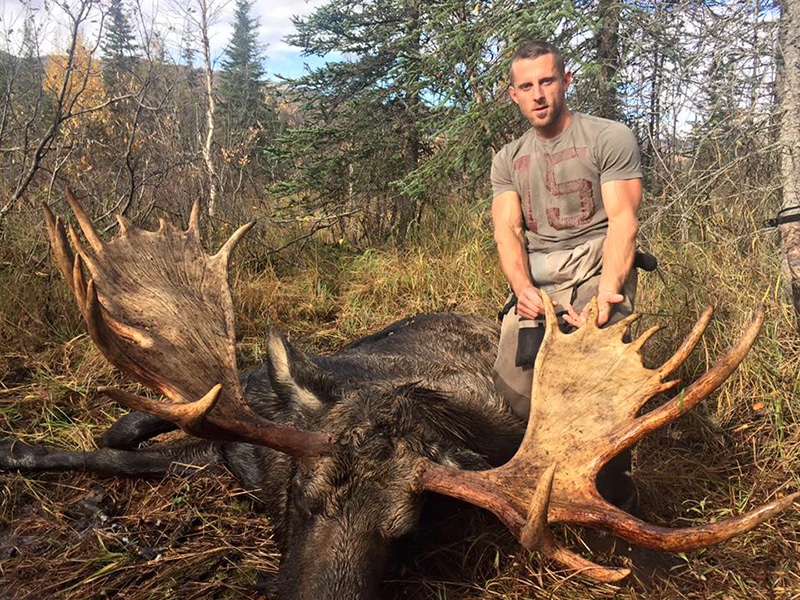
Don’t let moose hunting season pass you by without checking off that moose hunting trip from your bucket list. With their great size, awesome power, and flavorful meat, moose are valuable to a lot of hunters above all other big game. Venture into Alaska’s virgin, unspoiled territory when you join us at River Rock Lodge and experience the hunt of a lifetime for a trophy moose!
BOOK YOUR MOOSE HUNT
A guided River Rock Lodge moose hunt in Alaska can’t be beat. With an expert Alaskan guide, flexible approach to hunting, and quality food and camp lodging, you’re in for a legendary moose hunting experience! Book our all-inclusive moose hunting trip today!
MOOSE HUNT —-$22,500
Pricing is for a 7-8 day hunt.
- Quality Camp Lodging
- Hearty Food & Drink
- Experienced Alaskan Guide
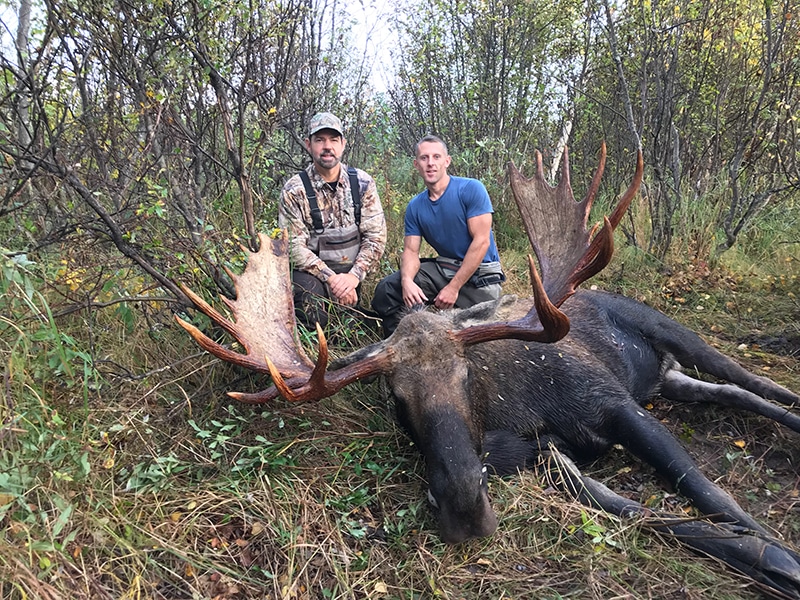
A guided River Rock Lodge moose hunt in Alaska just can’t be beat! With an expert Alaskan guide, flexible approach to hunting, and quality food and camp lodging, you’re in for a legendary moose hunting experience! Book our all-inclusive moose hunting trip today!
MOOSE HUNT ———- $16,500
Experience world class moose hunting on the kenai.
Book an all-inclusive moose hunting trip with River Rock Lodge and enjoy an epic trophy chase with a guide known for putting clients in front of big game!
SEND A HUNTING INQUIRY CALL NOW!
Frequently Asked Questions
When are the hunting seasons for moose, bear, and ptarmigan, what do i need to bring on my trip.
Camp lodging and meals are included in all of our hunting packages. All hunters are on the hook to bring is a sleeping bag and weather-appropriate clothing, plus their firearm, tags, and hunting license.
Are hunting tags included?
Can i hunt in alaska as a non-resident.
Absolutely, with the only stipulation being that all non-residents must be accompanied by an Alaska-licensed guide to hunt big game animals, including black bear, brown/grizzly bear, and moose.
Do you guide for bowhunters?
From archery hunters to rifle and muzzleloader hunters, we welcome hunters of any type and can guide whatever type of hunt you are looking for: fly-in, spot, or camp & stalk.
Do the hunting packages include any nights at the Lodge?
Hunting packages do not include any nights at the main lodge, though they do include 7 or 8 nights of quality camp lodging while on your hunt. Accommodation at River Rock Lodge can be added before or after your hunt for a discounted price.
How do you accept payment?
Sign up for our newsletter.
Be the first to hear about the latest specials, and fishing updates. Join the River Rock Lodge Newsletter!
MAKE A HUNTING INQUIRY
I am interested in hunting in:
I am interested in the following hunts (check all that apply)
Moose Hunt Spring Den Brown Bear Hunt Brown Bear Over Bait Hunt Black Bear Over Bait Hunt
HAVE YOU TRIED OUR TRIP BUILDER YET?
Get the most out of your fishing trip by customizing it with awesome activities and did we mention custom trips also get special nightly rates.
Alaska Moose
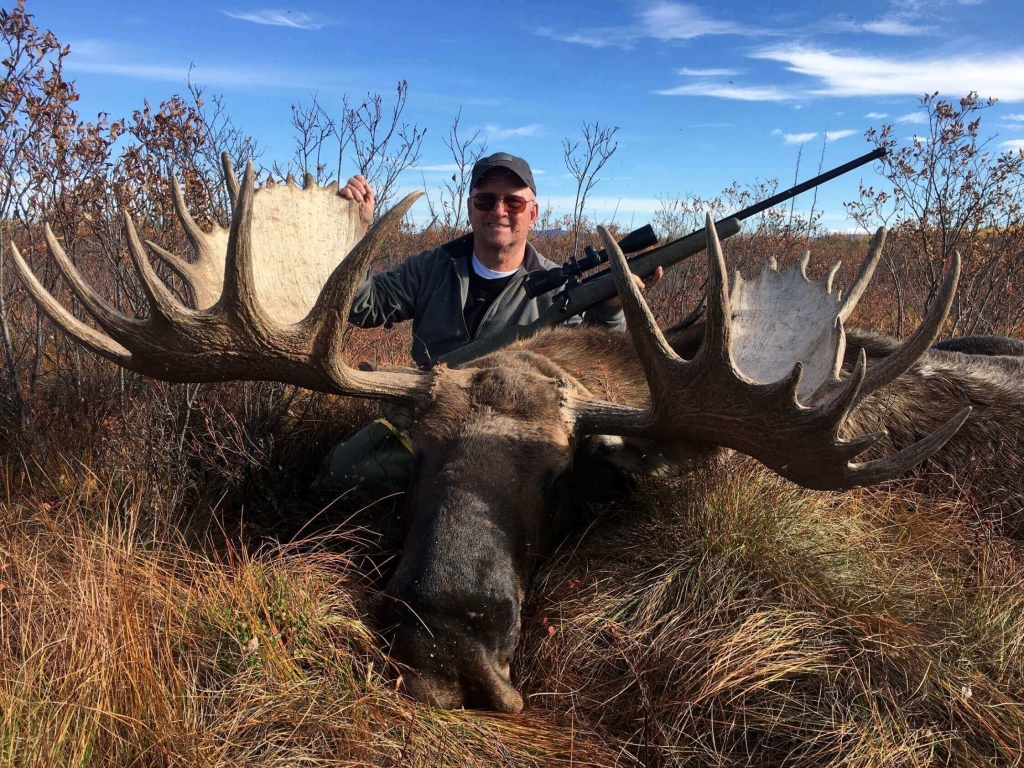
ALASKA MOOSE HUNTING
Premier trophy alaskan moose hunting with ben holbrook.
A Professional Trophy Moose Guide for nearly 20 Years in Alaska
MOOSE HUNTING
Each Hunter will be provided with their own guide and camp with 10 full hunting days if needed. Meat will be delivered to the processor and trophies delivered to the tanner/shipper at our expense. License and tags are available in camp. Trophy fees for Moose are included in the hunt cost. Grizzly, Black Bear, Wolf & Wolverine are additional animals and a trophy fee is due after animal is taken.
Our Moose Hunting Alaska Trips use jet boats and canoes to hunt along the river and nearby sloughs. Calling, spot and stalk, and still moose hunting along one of the many sloughs are all productive methods of hunting in this area. Calling is usually done along the river or a slough by using cow calls, bull grunts, and thrashing the brush to imitate bull moose. Calling a trophy Alaskan moose right up close is a real thrill that you will not soon forget! There are also some good lookout points from nearby hills. These are a great place to spot moose early in the morning and in the evening. Most of the shots are typically less than 200 yards.
EXPERIENCED GUIDES FOR MOOSE HUNTING ALASKA
Our Moose Hunting guides all have the experience it takes to make your moose hunting Alaska trip a success. They will hunt at your pace to ensure that you enjoy your time hunting with us. Your hunts’ success along with your safety and comfort are all major priorities while you are in our camp. Your guide will also take care of your trophy moose by fleshing the cape, turning the ears, splitting the lips, and then salting it well to make certain it is in top quality condition for your trophy room.
A few Snapshots from our Moose Hunts
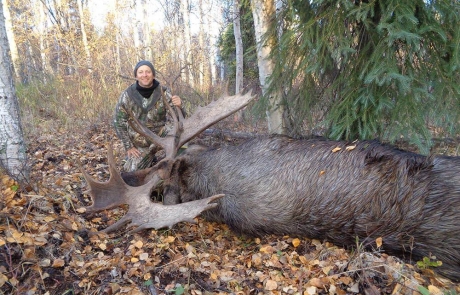
Would you like more information about this hunt? Reach out at:(907)-803-3552 OR (907)-616-1042 or

- Grizzly Bear
- Worldwide Hunting Consultant
- Wisconsin Whitetail Hunts
- Upcoming Events
Perhaps no other animal symbolizes the wide-open wilderness of Alaska better than a giant bull moose. Super Cubs land on ridge tops and all hunting is conducted on foot, thereby all but eliminating competition from resident hunters. Unlike most moose country, the terrain is mostly firm and semi-open, which is conducive to spot-and-stalk hunting and makes for a very enjoyable experience. Most bulls are called-in, as the rut is typically in full swing. After a trophy bull is down, packers are flown in to help pack out the meat to allow the hunter time to find a grizzly or black bear. Guided success typically hovers around 90%, average bull is over 60 inches with most bulls having excellent mass and multiple brow points.
- 1×1, 10-days, $30,000-$35,000, with $10,000 trophy fee if grizzly is taken, $5,000 if caribou is taken.
All prices subject to change.
All hunts listed do not include transportation to nearest Alaskan airport, hunting license, tags, gratuities, or shipping of trophy from Alaska to your home.

Alaska Moose Hunting
.jpg)
2023 Hunting Rates:
Alaska moose hunting 10 day 1x1: $21,000, moose & brown bear combo 10 day 1x1: $24,500.
NO TROPHY FEES! NO HIDDEN FEES!
Location: Unit 14, 16, 20
Hunting Dates: September 5-14 & Sept 16-25
Experience Alaska moose hunting with Alaska's Ultimate Trophy Hunting. Our guided trophy moose hunting trips take place in the shadows of 20,308 foot Mount Denali.
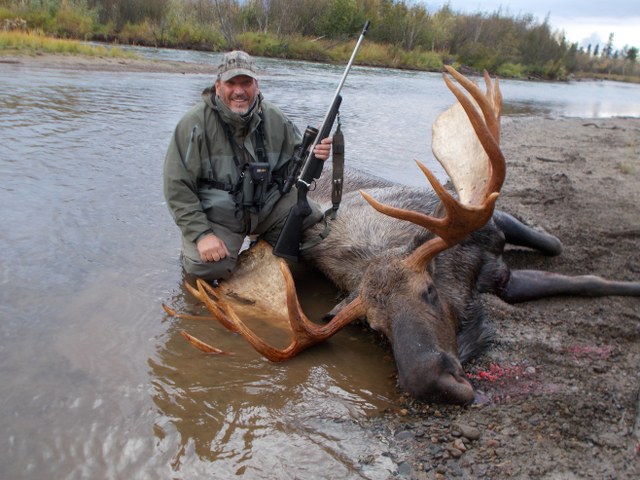
ALASKA MOOSE HUNTING SUCCESS: We want to stress that we don't guarantee success. With that said, these are HIGH success hunts. The harvested bulls range between 55 and 65 inches. However, we do have encounters with bulls over 70 inches in this area. As good as this hunt is, and as good as it has been, please remember that this is a fair chase hunt. The way we hunt is a big reason for our success. Some Alaskan Outfitters want to filler their bookings throughout the entire moose hunting season from August through September. September is by far the best time to hunt moose. Any other time can be tougher. We book hunts only the prime times in the season which is during or near the rut. We refuse to book hunters during the slow times of the season. To us, success is more important that booking more hunters.
ARRIVAL: Once you make it to Anchorage, you can rent a car at the airport and take a scenic drive north 100 miles (about 1 1/2 hour drive) to meet us. This is also useful so that you can come and go and spend time seeing after you harvest your moose.
BEFORE THE HUNT: We like to have you shoot your gun before we go into field to hunt so we know it's zeroed in. Our moose hunts take place generally 125 miles northwest of Anchorage Alaska. It's best to fly into Alaska a day before the hunt so we can prepare for your hunt. Alaska laws prohibit hunting the same day you fly in an aircraft. Because of this, you will be in your hunting camp the day before we hunt.
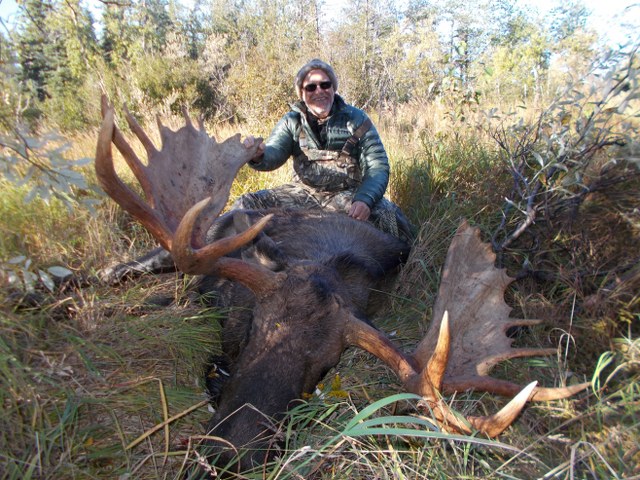
CAMPS: Most of our moose hunts will be remote and will have a spike camp. We place spike camps in remote areas that we know hold large concentration of bulls. We live here and have spent many years scouting, so we know those areas that hold the trophy bulls you are looking for. We pride ourselves in using quality equipment. Our tents are high quality bomb shelter tents. These are known for their highly waterproof qualities as well as the durability in high wind. We provide a tent, cot, pad, food, heater and game bags.
FOOD : At most camps we will use mountain house brand food due to the airplanes weight restrictions. We also bring summer sausage, jerky, lunch meats, cheese, bread, bagels, crackers, candy bars, breakfast items, cookies and various snacks. We always bring more than what is needed. Please let me know if you have any food allergies. We can customize the food to suit you if needed.
GEAR: Airplane weight restrictions mean we limit to a maximum of 50 pounds of gear per each hunter. Get a gear list for the moose hunt here .
WEATHER: in September, most mornings are around 30 degrees. It's generally frosty and crisp-which is perfect for our Alaska moose hunting. The afternoons usually warm to around 45-50 degrees. Then it cools off overnight as the northern lights come out to dance across the star filled sky.
MOOSE HUNTING TERRAIN: We primarily hunt the black spruce right at the timber line. This is where we call moose with bull grunts and cow moans into clearings and meadows.
CARE OF TROPHY: Your moose will be skinned in the field by a professional Alaskan guide. once back in anchorage, the trophy will be taken to a quality taxidermist for proper fleshing, salting and sealing. We can recommend a local taxidermist here in Alaska to mount your trophy, or you can take it to one of your choice.
WE PROVIDE: All camping equipment required for the hunt, not to include any other personal gear and clothing of the hunter. All food, water, shelter, cooking, and equipment will also be included. Anything required to conduct the contracted hunt will be provided, minus the personal gear and weapons of the hunter.
YOU PROVIDE: Hunters provide moose tag , hunting license, moose harvest ticket, gun, bullets, personal gear, binoculars, zero-degree rated synthetic sleeping bag, 30 caliber gun.
COSTS NOT INCLUDED IN THE ALASKA MOOSE HUNTING TRIP:
- License prices are below. However, please verify and get detailed license tag fees and Alaska moose hunting season info here: https://www.adfg.alaska.gov/index.cfm?adfg=huntinglicense.prices
- Non-Resident License: $160.00
- Non-Resident Moose Tag: $800.00
- Airfare to and from Anchorage
- Hotels Before and After Hunt
- Shipping of trophies and meat
- Any Other Costs While Not in the Field
- Air Taxi Fees
Are you ready to experience an adventure of a life time? Try Alaska moose hunting with us. We pride ourselves in providing high quality hunting and service at an affordable rate. Ready to book a hunt? We look forward to sharing ultimate adventure. Contact us today !

Alaska Moose Hunting
Guided moose hunts.
Alaska Moose Hunting is a staple of adventure as well as table fare for most born and raised Alaskans. Large enough to feed whole families, yet they can be elusive to find. The Moose is a browser and lives on the saplings of the willow and occasionally feeding on water plants. In our Exclusive Use Area on the Alaska Peninsula we have all the right elements to produce Trophy class Bull Moose. Starting with an abundance of browse, wetlands and a temperate climate. Adding to the list, is the lack of hunting pressure this area sees. Historically, we never hunted Moose on this part of the Refuge and 2021 will be the first year we actively take advantage of these permits.
Moose season begins Sept. 10 – Sept. 25 in Unit 9E. We hold 3 permits in hand and its pay to play. In other words they are over the counter tags. In order to confirm a Moose Hunt with Vast Alaska, all you have to do is make a deposit and we will put it in ink. To clear up any confusion, this area is not new to us. We hunt Brown Bear in this Refuge Area, but this will be the first time we utilize our Alaska Moose Hunting Permits in this particular area. Another thing to consider is, we support all our hunts in this familiar country with our own Aircraft. We own 2 Super Cubs and all bush flights are included. For a sneak preview, Check Out one of our past hunts Here.
Hunt Details
- Season : September 10 – 25
- Duration : 10 Days
- Location : Alaska Peninsula
- Units : Unit 9E, Exclusive Use
- Guide to Client : 1:1
- Cost : $ Call for Pricing
“In order to give a Bull Moose the proper respect one needs to see it on the hoof, eye to eye and to place yourself amidst a Rut of dozen Cows and Bulls is to witness something from the Pleistocene.” – Cash Joyce
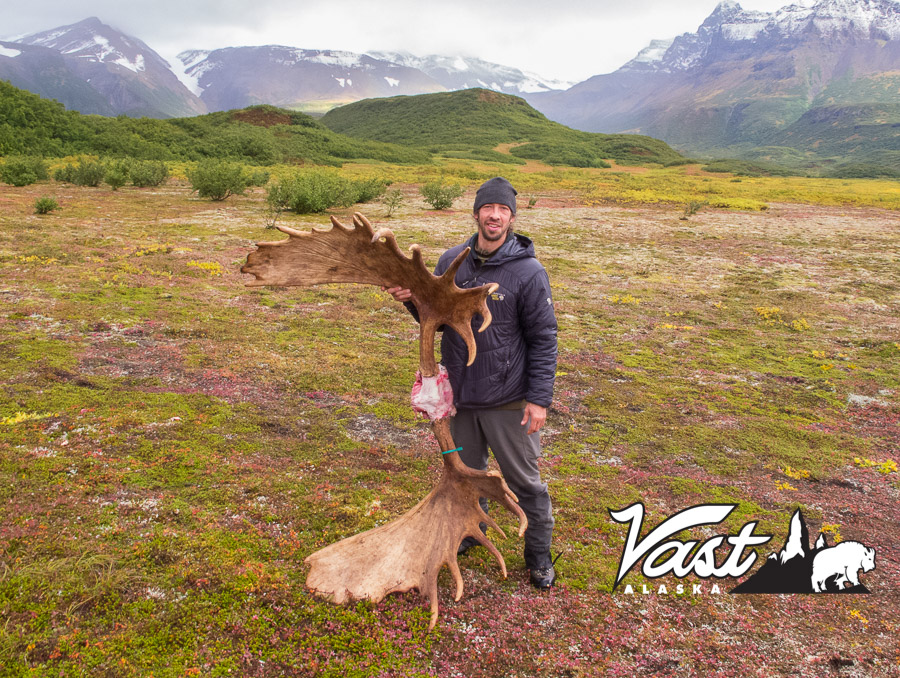
Locations of our Moose Hunts
Alaska Moose Hunting in Unit 9E. We hunt moose in a Refuge on the Alaska Peninsula. The climate and the forage breed exceptionally large bull moose, trophy size. There are considerable logistics to hunt in our Federal Concession. So we take a small number of hunters each year for this limited entry hunt. This is brown bear territory and the weather can be formidable. With the Aleutian Range and the Bering Sea generating significant weather. But the raw atmosphere will make it worth the trip and the extra expense.
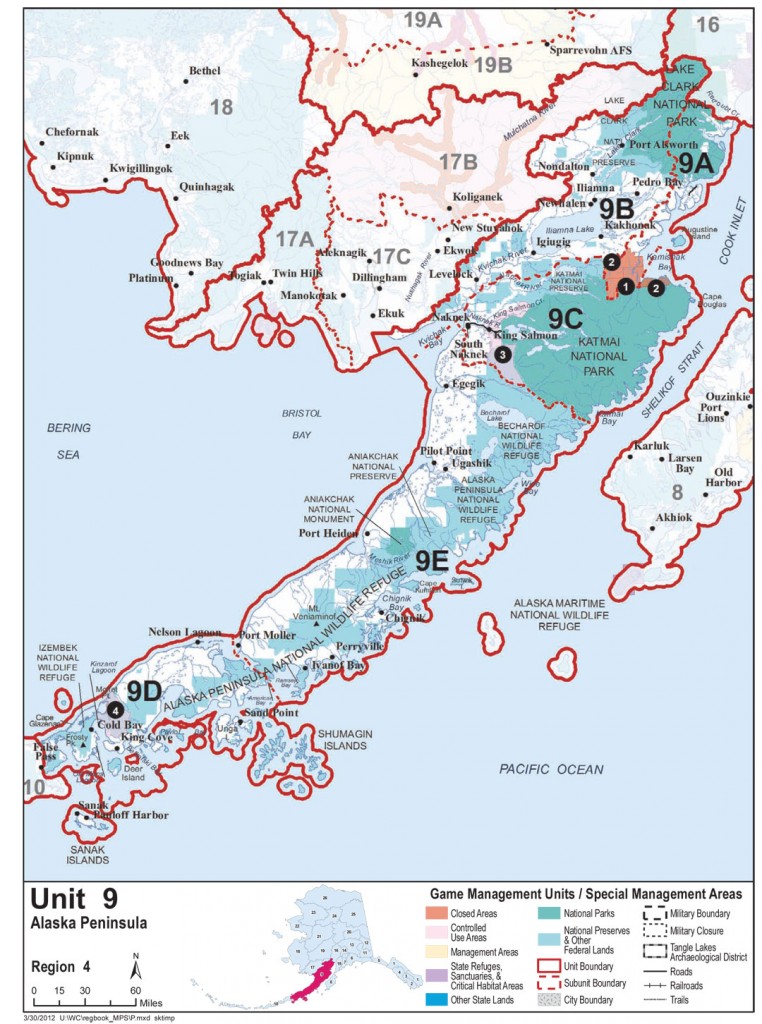
Copyright © Vast Alaska. All rights reserved.
Alaska Guided Moose Hunts
How much does it cost for a moose hunt.
The 2024 price of a fully outfitted, 10 day guided moose hunt is $22,500.
For more information on rates, deposits and Combo hunt prices, check out the hunt prices page.
Alaska Moose Hunting Season
For available bookings, questions about our operation, or to request a reference list please Contact Alaska Adventure Outfitters .
For more outfitter information and available hunts visit the Home Page
We encourage you to compare us with other moose outfitters.
Here is a list of registered Moose hunting guides in Alaska : Alaska big game hunting guides and outfitters
Copyright 2021 Alaska Adventure Outfitters, LLC
The Ultimate Guide to Moose Hunting in Alaska
by Deziree Lambert | Jan 22, 2024 | Alaska Hunting | 0 comments
The Ultimate Guide To Moose Hunting in Alaska:
Everything hunters need to know….
Alaska, the last frontier, is home to some of the most exhilarating big game hunting experiences in the world. Moose hunting stands out as a true Alaskan adventure that attracts avid hunters from all corners of the globe. But with the thrill of the chase and the majesty of the landscape come important guidelines and considerations to ensure a responsible, successful hunt. In this guide, we’ll explore the optimal times for moose hunting, the regulations that you need to follow, differences between resident and non-resident hunting requirements, and typical success rates.


Non-Residents vs Residents
The state of Alaska offers different rules for resident and non-resident hunters. Residents have the privilege of being able to hunt without a guide and are provided more opportunities in terms of available units and tags.
Non-residents, on the other hand, may be required to hunt with a licensed Alaskan guide or be accompanied by an Alaskan relative within the second-degree of kindred. Non-residents also face higher tag costs and may be subjected to a lottery or limited quota system in certain areas, limiting the number of non-resident hunters each season.
For those traveling from out of state, be prepared for a significant expense. Hiring a guide, obtaining non-resident licenses, and transporting trophies home can add up. However, the unparalleled experience often justifies the investment for serious hunters.
Success Rates | Moose Hunting Alaska
Success rates for moose hunting in Alaska vary by unit, hunter experience, weather conditions, and accessibility to remote areas. On average, around 10-20% of moose hunters in Alaska are successful, though rates can be higher in specific regions well-known for their moose populations.
To increase chances of success, many hunters opt to use bush planes to access more secluded locations where moose are less pressured by hunting activity. Additionally, experienced guides can greatly enhance the likelihood of a successful hunt, as they are familiar with the terrain and moose behavior.

Em ail: [email protected] | Phone: 907.435.4019 | Mail: Po Box 1421, Homer, Ak 99603
Crafted by Outfit Alaska LLC © 2023 All Rights Reserved
Share this:
Leave a reply cancel reply, discover more from outfit alaska.
Subscribe now to keep reading and get access to the full archive.
Type your email…
Continue reading
Alaska Bush Adventures
480-657-3174

Alaska Bush Adventures Base camp
Alaskan Big Game Hunting Services
Welcome to alaska bush adventures located in southwestern alaska, moose, caribou, brown-grizzly bear, black bear.
Hugh Krank came to the great state of Alaska in 1978 to experience hunting big game in Alaska's vast secluded wilderness and became forever hooked on the Great Alaskan Outdoors. After years of awe-inspiring, hunting and fishing adventures, he discovered a region in Alaska that offered tremendous hunting opportunities where no other Guide/Outfitters were operating. In 1985 he started Alaska Bush Adventures, ("ABA") a small family owned Alaskan Guide and Outfitter Service in a remote and quiet area of Southwestern Alaska. Hugh and his Son Ryan, are both Alaskan Master Guides and their long time employees consists of Roy Austin, Registered Guide and Mike McCarey, Assistant Guide, have been part of the team since the 90's. They have many years of experience in Guiding for Brown Bear, Black Bear, Caribou, Moose and all are experienced in calling and raking for Moose plus the habits of all Alaska's big game species, which will give you an edge on harvesting these big game animals.
For over 38 years they have operated their family owned Guide and Outfitter Service with seasoned Alaskan Guides, respecting the rules and concepts of ethical fair chase hunts. Offering authentic and unforgettable Guided Alaskan Big Game hunting experiences for Moose, Brown/Grizzly Bear and Black Bear.
Their float trips for a DIY Unguided Moose hunt, are fully outfitted/supplied with all but what your personal gear includes. The Alaskan Barren Ground Caribou hunts are fully outfitted/supplied fly out spike camp hunts that take place in the low rolling foot hills on the Northwestern side of the Alaska Range. You are provided a "suggested personal gear list" and detailed lists of all the equipment/supplies, food and drinks included by Alaska Bush Adventures for your hunting trips in Alaska. We strongly suggest taking advantage of the information provided on the FAQ (frequently asked questions) page within this website, as it will have these lists and much more helpful information to help prepare you better for a hunt with Alaska Bush Adventures.
The territory where they provide hunting services or their Guide Use Areas (GUA’s) is a quiet and secluded region, 250 plus miles west of Anchorage. It takes a minimum of 2.5 hours by a bush plane on floats to reach these river systems to hunt within the wild untamed wilderness country of Southwestern Alaska. All guided clients will enjoy numerous creature comforts of the well-stocked and maintained basecamps located along the river. They will hunt for Moose using Jon boats powered by jet-drive outboard motors which provide a huge advantage when traveling within the rivers shallow branches, ox bows and back water sloughs where Bull Moose are rutting and gathering up their cows to breed.
The Unguided, DIY, river float hunting trips for Alaska Yukon Moose and Barren Ground Caribou drop camp hunts are fully outfitted and supplied with camping equipment/gear and a generous arrangements of food/drinks for your meals. The DIY Unguided Moose river float hunts are also outfitted/supplied with rafts, cargo platforms, rowing frames, oars, life jackets and the balance of the necessary equipment to complete this type of a float hunting trip for Moose.
They have worked diligently to create, maintain and enhance the access and the exit from the river. This is the only location on the river within this Alaskan Game Management Unit where you can both land a float plane safely take a fully loaded plane of harvested big game animals and the hunters off the river and back to town. We typically use DHC-2 De-Havilland Beavers equipped with wing tip fuel tanks to provide the plane extended flying time to safely reach out to our hunting area and back to town. The distance from any major community and the restricted access to land a plane in the area undeniably affords hunters an enhanced opportunity to achieve success and enjoy a significant level of comfort while doing so. Being able to hunt in Alaska without having to worry about another hunter ruining your stalk on an animal or hunting pressure from hunters in the area, is a wonderful experience.

Alaska Bush Adventures Guides Ryan & Mike
History of Hunting in Alaska
HUNTING IN ALASKA AND WHAT TO EXPECT
Hunting big game in Alaska is a substantial investment, not only financially but includes spending a lot of time preparing, researching, and planning to find a reputable Guide/Outfitter hunting service for your hunt. Alaska Bush Adventures knows the importance of providing a variety of logistical information to prepare our client’s before during and after the their trip in hopes of ensuring a great Alaskan hunting experiance. We believe that our “hands on knowledge” of the our GUA’s, local game populations and their habitat where you will be hunting is beneficial and relevant in your choice of a Guide Outfitter. We are not a fly-by-night hunting service and we believe action speaks louder than words. Year after year we have learned something new and or a better a way to fine tune the Alaska hunting services we make available to our client’s. Because of the financial investment and what a hunting experience of a lifetime like this represents to you, we encourage you to call us to discuss in detail our services and to answer your questions. To gain the knowledge necessary and to be familiar with what to Know and expect before, after and during your hunting trip in Alaska, we encourage you to call us and spend some time visiting on the phone. There is a lot to go over about the infrastructure, full-service logistics, and a variety of useful services in Anchorage for taking care of your harvested game.
Alaska has a healthy Big game population of Moose, Caribou, Brown Bear, Black Bear, and Wolves, but in part, due to its size has fewer big game animals per square mile than any other state. They are in general thriving best in remote regions of the state with the type of habitat that is vital to sustain them year round and have not been over hunted for decades due to easy access and being close to heavily populated areas.
We provide our clients with a complete Itinerary of the logistics and information to illuminate the other types of services available to them. Information on Hotels, Bush Plane flights, Meat, and Trophy care options, and shipping info to get your game home. Meat processors, Taxidermists, Expediting Services, a Suggested Equipment List, and much more. We encourage you to also contact our references as often, they are happy to share their experiences with you and are able to answer some of your questions in a different light providing valuable first-hand knowledge.
Our Alaska hunting camps are located within sight of the Alaska Range in the Kuskokwim Valley and its numerous tributaries. Our Guided Clients hunt can from any one of our three base camps located on remote wilderness river systems. These hunting areas are only accessible by a bush plane on floats with extended range fuel tanks. We have enhanced the only access and exit landing strip on the river for bush planes that allows for the plane loads needed to operate efficiently within the headwaters of the river systems where we Guide and Outfit our hunts .
They are one of the few Alaskan Guide Outfitter Services that offer such a wide variety of specialized equipment for our hunting Clients to get around in the mountains and rivers of the Alaskan Wilderness.
There is healthy, Moose, Caribou, Brown Bear, Grizzly Bear and Black Bear, population in our area. Most of our hunts take place on the rivers using Jon Boats with Outboard Motors powered by Jet Units instead of props or we can take advantage of our 8 wheel drive Argos to hunt for the Moose and Bears in the surrounding rolling hills & valleys. Having the advantage of Jet powered Jon boats and the Argos offers an increased level of service & success, especially for those who are not in the prime of their life or may have physical disabilities.
We fully outfit our DIY Unguided Moose hunters to do river float hunting trips within the remote upper headwaters of the same river systems we conduct our Guided Clients Moose hunting trips on utilizing Jon Boats powered by Jet-drive Outboard Motors.
FAQ's - WHAT TO EXPECT / IMPORTANT INFORMATION

2024 Photos & Text Copyright - © Alaska Bush Adventures 3plains.com - Outfitter Web Design
Back To Top
Alaska Wilderness Enterprises, LLC
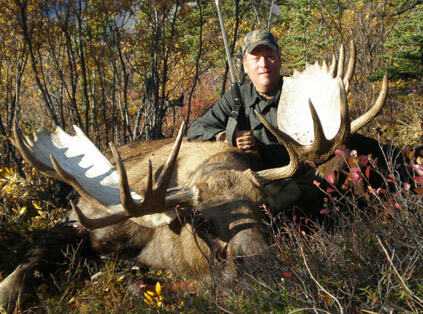
Moose Hunting Alaska: Your Friendly Guide to Success

Moose hunting in Alaska is a thrilling and rewarding experience for both novice and seasoned hunters alike. This exciting outdoor activity not only creates lasting memories but also provides a unique opportunity for hunters to connect with nature and appreciate the vast wilderness that Alaska has to offer. With an estimated population of 175,000 moose across the state, hunting enthusiasts have ample opportunities to pursue and harvest these magnificent creatures.
Our Moose hunts take place in the Alaska Range south of Fairbanks. This area of the Alaska Range, with its heavy willow draws and large open meadows, provides an ideal habitat for some of the best moose hunting in Alaska.
Both Moose and Grizzly can be hunted individually or in a combination hunt. There is an abundant population of both species, with an excellent opportunity for trophy animals. The area regularly produces 60” bulls and Grizzly up to 9’ square.
At this time of year, the full spectrum of fall colors is a sight not easily forgotten. Base camps vary in some locations, from cabins to Cabela’s dome tents with a separate cook tent for meal preparation.
The Alaskan landscape presents diverse hunting environments, allowing hunters to employ different strategies and techniques to maximize their chances of success. In the fall, moose often migrate from their summer habitats to higher elevations to partake in the rutting season.
This natural movement presents a prime window for hunters to spot and harvest trophy bull moose. The use of jet boats or other efficient modes of transportation enables hunters to access remote hunting locations, where skilled guides and outfitters are indispensable for a successful and memorable experience.
It is essential for hunters to familiarize themselves with Alaska’s hunting regulations and obtain the necessary permits and equipment before embarking on a moose-hunting adventure. Ethical hunting practices, proper preparation, and adherence to safety guidelines will ensure a sustainable and enjoyable experience for all participants, preserving this cherished Alaskan tradition for future generations.
10 Day Hunt: $20,500 14 Day Hunt : $24,500
Moose and Grizzly Combo
10 Day Hunt: $36,000 14 Day Hunt: $39,000
Related Hunts
- Grizzly Bear
- Mountain Goat
Alaska Moose Hunting Overview
Moose hunting in Alaska usually takes place during the fall season, when the moose population is at its highest and the animals are most active. During this time, hunters can participate in various types of hunts, such as antler-restricted moose hunts or open-season hunting.
When participating in a moose hunt, it is essential for hunters to be familiar with the regulations and requirements set by the Alaska Department of Fish and Game . This ensures that only legal game is harvested, and it helps to maintain a sustainable population for future generations to enjoy.
Moose hunting in Alaska can be both challenging and rewarding. The terrain is often rugged, and the weather can be unpredictable, requiring hunters to be well-prepared and adaptable. However, the opportunity to hunt the Alaska-Yukon race of moose, which is the largest of all moose subspecies, makes the experience even more exciting.
One of the most critical aspects of moose hunting is locating the animals. Moose are known to be elusive and can be difficult to find, especially in the dense Alaskan wilderness. However, hunters can increase their chances of success by studying moose behavior, habitat preferences, and migration patterns.
Alaska moose hunting is a popular and essential activity that provides both sustenance and recreational enjoyment for many people. By understanding the regulations, preparing well, and respecting the environment and the animals, hunters can have a safe and successful experience in this unique Alaskan adventure.
Moose Species and Life History
North american moose.
The North American Moose, scientifically known as Alces alces, is the largest member of the deer family. They can be found across the continent, with a notable presence in Alaska, where the Alaska-Yukon race (Alces alces gigas) represents the largest of all moose species . These majestic creatures have a complex life history, adapting to various environments and food sources throughout the year.
Moose in North America have distinct features such as:
- Large antlers: Bull moose (males) grow impressively large antlers, shedding and regrowing them annually.
- Long legs: Moose have long legs, which allow them to navigate through deep snow and uneven terrain with ease.
- Size: North American moose can stand up to 7 feet tall at the shoulder and weigh more than 1,000 pounds.
Their life cycle includes a mating season called the rut, which occurs in the fall. During this time, bull moose become more aggressive and actively seek out females, or cows, to mate with. Cows typically give birth to one or two calves in the spring, providing care and protection before the young become more independent within a year.
European Moose
In Europe, moose are known as elk (Alces alces) and share many similarities with their North American counterparts. Although they are quite comparable in terms of appearance and behavior, some differences can be observed:
- Size: European moose tend to be slightly smaller than North American moose, weighing up to 1,100 pounds and standing around 6.5 feet tall at the shoulder.
- Coloration: The European moose has a lighter coat color compared to the dark brown fur of the North American moose.
The life history of European moose is also quite similar to that of their North American counterparts, with mating occurring during the fall rut and calves being born in the spring. However, hunting regulations and conservation efforts may vary between countries, impacting the overall European moose population differently.
Moose Habitat and Food Sources
Moose inhabit various types of habitats in Alaska, with their diet changing depending on the season and availability of food sources. Their diet primarily consists of vegetation, including willow, birch, aspen, sedges, grasses, forbs, and leaves. Moose are also known to feed on aquatic plants found in water sources such as ponds.
Moose in Meadows
Moose love meadows due to the abundance of forbs, grasses, and sedges that make up their summer diet. Meadows provides a variety of nutritious plant sources that moose can graze on from leaf-out in May until September. Aquatic plants found in water sources within meadows are also an essential part of the moose’s diet, providing them with additional nutrients and hydration.
Moose in Brush
Moose can also be found in brushy areas, where willow, birch, and aspen trees dominate the landscape. The leaves of broad-leaf trees and shrubs serve as a significant food source for moose during the warmer months. These habitats provide moose with shade and cover from predators, making them ideal spots for these majestic creatures to thrive.
Moose Season and Timing
Moose hunting in Alaska is a popular activity, drawing hunters from around the world. The moose hunting season varies depending on location and time of year, with opportunities available throughout the year. In this section, we’ll discuss the specifics of moose hunting during different seasons.
Spring Moose Hunting
During the spring, moose are often found near their wintering grounds as they start to migrate toward their summer range. Hunters who venture out during this time may have the chance to spot moose in more open areas as they forage for newly sprouted vegetation. It’s worth noting, however, that spring is not considered a prime time for hunting moose in Alaska, as most of the hunting seasons typically begin in August and September .
Summer Moose Hunting
As the summer progresses, moose can be found grazing in lush, green habitats, usually within close proximity to water sources. Though hunting moose in the summer may present unique challenges with warm weather and dense vegetation, success can still be achieved with careful planning and preparation. Please note that specific regulations and permits may apply for summer moose hunting in Alaska .
Fall Moose Hunting
Fall is the most popular time for moose hunting in Alaska, with many hunters targeting the pre-rut and rut periods. During the pre-rut in late August and early September, moose begin to prepare for the breeding season. This is an optimal time for hunting, as their behavior becomes more predictable, and they are more likely to be in open areas.
As the rut begins in late September and early October, moose become more active, with bulls looking for cows to breed. This heightened activity can make for a more exciting and challenging hunt. However, it’s important to note that regulations vary by hunting unit, with specific tags and permits required for different areas and moose populations .
Winter Moose Hunting
Winter moose hunting in Alaska can present some additional challenges with colder temperatures and harsher terrain. However, moose may be easier to spot against the backdrop of snow-covered landscapes. In some areas with large moose populations and where local subsistence needs are met, hunting may be permitted year-round . As always, it’s crucial to check the local regulations and requirements before embarking on a winter moose hunt.
Moose Hunting Techniques
Calling moose.
A popular and effective technique when hunting moose in Alaska is to call out to the animals, primarily focusing on attracting bulls during the rutting season. Using a combination of both cow and bull calls can increase your chances of success. To create a realistic cow call, cup your hands and imitate the moose’s nasal and guttural sounds, while a trombone-style call or megaphone can mimic the deep and rattling grunts of bulls. Make sure to practice these calls regularly before your hunting trip, as moose can be quite responsive to well-executed vocalizations. Remember to be patient and alert, as it may take a while for a moose to appear after hearing your calls.
Glassing for Moose
Another effective technique for moose hunting in Alaska is glassing, which involves using binoculars or spotting scopes to survey the landscape and locate moose from a distance. This method is especially useful in open, rolling terrains where moose are more likely to be spotted. Start by scanning the area slowly and methodically, taking note of any potential movement, changes in color or shape, and focusing on places where moose might be resting, like near water or in thick brush.
When glassing for moose, keep in mind the importance of differentiating between bulls and cows. While both can be spotted relatively easily, bulls have large, distinctive antlers during the hunting season which makes them easier to identify. Additionally, take note of the time of day, as moose are often more active during the early mornings and late afternoons.
Utilizing these techniques, such as calling and glassing, can significantly improve your chances of a successful moose hunt in Alaska. Just remember to practice your skills, be prepared, and remain patient in the field.
Moose Trophies and Harvesting
Trophy moose.
Alaska is home to some of the largest moose in the world, making it a popular destination for hunters seeking trophy animals. A trophy moose is typically characterized by the size of their antlers, which can span over 70 inches in width. Hunters in Alaska have been known to harvest moose with antlers up to 77 inches wide , showcasing the impressive size of these animals in the region.
Meat Harvest
Hunting moose in Alaska also provides a bountiful source of meat. Each year, hunters harvest over 7,000 of Alaska’s estimated 175,000 moose . The substantial size of these animals translates to a significant amount of meat, often ranging between 500 and 700 pounds of edible meat per animal.
When it comes to harvest reporting, Alaska requires hunters to report their moose harvest, providing valuable data on the overall success of the hunting season 2 . These harvest statistics help the Alaska Department of Fish and Game manage and maintain a healthy moose population, ensuring the sustainability of the Alaskan moose hunting tradition.
In summary, moose hunting in Alaska offers both the opportunity for impressive trophy animals and a plentiful source of meat. The state’s abundant moose population and careful management through harvest reporting ensure a vibrant and sustainable future for this popular sport.
Moose Hunting Regulations and Permits
Alaska board of game.
The Alaska Board of Game is responsible for creating and managing the moose hunting regulations in the state. This includes setting the season dates, bag limits, and the conditions for the issuing of moose permits. Each year, the regulatory year begins on July 1st and ends on June 30th the following year. In Alaska, moose hunting regulations are designed to manage the moose population in a sustainable manner, ensuring that this popular big game species remains abundant and accessible for hunters.
Moose Permits
Moose hunting in Alaska typically requires obtaining a license and a permit. There are various types of permits, such as registration permits (RM), draw permits (DM), and Tier II permits. The specific permit a hunter needs depends on the location and the type of moose hunt.
Registration permits, like the RM865 , are available online or in person at certain ADF&G offices and select vendors in some locations. The RM865 permit, for example, allows the hunter to target one bull moose with 50-inch antlers or antlers with 4 or more brow tines in specific areas during the season.
Draw permits are issued through a lottery system, and hunters can apply online. The success rate and availability of these permits depend on the number of applicants and the allocated hunting slots for specific areas.
Tier II permits are for subsistence hunting and are open to Alaskan residents only. They are issued based on specific criteria and the needs of subsistence hunters, helping to preserve the moose population for traditional cultural practices.
It is important for hunters to be aware of and follow the specific regulations and requirements for their chosen moose hunt. Many areas also require hunters to complete a Basic Hunter Education course before they can participate in a moose hunt. Additional information about moose hunting regulations and permits can be found on the Alaska Department of Fish and Game website .
Hunting Opportunities in Alaska
Guided moose hunts.
Alaska is home to a large population of moose , making it a popular destination for hunters seeking a thrilling and rewarding experience. One option for those looking to maximize their chances of success while moose hunting in Alaska is to participate in a guided moose hunt.
Guided moose hunts provide hunters with an experienced guide who is knowledgeable about the best locations and methods for hunting these majestic creatures. These guides are familiar with the terrain, weather conditions, and moose behavior, significantly increasing the likelihood of a successful hunt. Alaskan Yukon moose are some of the largest moose in the world, making a guided hunt an unforgettable experience for any hunter.
High Success Rate Hunts
Another great option for moose hunting in Alaska is high success rate hunts. These hunts are often organized in areas known for their abundant moose populations and are designed to maximize the probability of hunters filling their tags during the moose season .
High-success rate hunts typically involve carefully scouting and tracking moose movements, and some may even involve stalk hunting, an exciting and challenging method that requires patience and skill. By participating in a high success rate hunt, hunters can increase their chances of bagging an impressive Alaskan moose, making their trip a truly memorable one.
When hunting for moose in Alaska, considering both guided moose hunts and high success rate hunts can provide hunters with the best opportunities to make their trip successful and enjoyable. With the right hunt opportunities and expert guidance, moose season in Alaska can be an unforgettable experience for every hunter.
Moose Predators and Competitors
In Alaska, moose populations face a variety of natural predators and competitors. Understanding the relationships between these animals is crucial for successful moose hunting and conservation efforts. This section will discuss three primary predators and competitors affecting the moose population: wolves, bears, and wolverines.
Wolves are one of the main predators of moose in Alaska. Being highly social and intelligent animals, they are capable of hunting large prey like moose by working together in packs. Wolves primarily target young, old, or weak individuals, helping maintain a healthy and robust moose population. It’s essential for moose hunters to be aware of the presence of wolves in their hunting area and how their hunting strategies may impact the local wolf population.
Alaska is home to two species of bears that pose a threat to moose: the black bear and the larger brown bear. Both species are known to prey on moose, with brown bears being more likely to hunt adult moose due to their size and strength. Black bears, on the other hand, tend to target smaller prey, such as moose calves. In addition to being predators, bears can also be considered competitors for moose hunters, as they may be attracted to the smell of a fresh moose kill and potentially cause conflicts with humans. Moose hunters should be aware of bear activity in their hunting areas and take necessary precautions, such as proper bear safety measures during hunting trips.
While not a significant predator of moose, the wolverine is still considered a competitor within Alaska’s moose-hunting ecosystem. Wolverines are known for their scavenging behavior, often looking for leftovers from other predators’ kills. Although they typically do not pose a direct threat to moose, their presence may indirectly impact moose populations, as well as the success of moose hunters. Being aware of the role that wolverines play in the ecosystem can help moose hunters make informed decisions about their hunting strategies and contribute to a more balanced and healthy environment for all species involved.
Moose Hunt Transportation and Equipment
Moose hunting in Alaska requires proper planning, transportation, and equipment. In this section, we’ll discuss the essential aspects of preparing for a successful moose hunt, including spike camps , jet boats , and passes .
Spike Camps
Spike camps are small, remote base camps used by hunters to access prime moose hunting areas. They typically include a basic tent, camp stove, and essential supplies for a few days of hunting. When choosing a spike camp location, it’s important to consider the proximity to prime hunting areas and the ease of transportation.
To set up a spike camp, hunters often rely on various transportation methods, such as floatplanes or helicopters, which can transport them and their gear deep into the Alaskan wilderness. Keep in mind that weight limits apply, so pack your gear wisely.
Jet boats are another popular transportation method for Alaskan moose hunting. They provide easy access to remote rivers and allow hunters to navigate shallow waters effectively. These boats can be rented or purchased and are an efficient way to cover large hunting areas quickly.
Before using a jet boat, ensure you have the required license and tags for moose hunting in Alaska. Also, familiarize yourself with local regulations and restrictions, which may limit boat usage in certain areas.
When planning your moose hunt, you’ll need to secure necessary passes for access to certain hunting areas. Some popular hunting locations may require an access pass, while others may only demand a standard hunting license. Research your chosen hunting area beforehand to determine any required permits, passes, or tags.
In addition, be prepared to transport your harvested moose and equipment from the hunting site back home. An average moose can yield 400 to 700 lbs of meat and up to 65 lbs of antlers , so proper transportation planning is crucial.
Remember to always respect wildlife and follow the required regulations to ensure a safe and successful moose hunt in Alaska.
Frequently Asked Questions
What is the cost of a moose hunting trip in alaska.
A moose hunting trip in Alaska can vary widely in price depending on factors such as outfitter, location, and duration. Typical hunting trips can range anywhere from $20,000 to $30,000.
How many moose are you allowed to hunt in a season?
In Alaska, each hunter is typically allowed a bag limit of one bull moose during a hunting season. However, specific regulations and limits might vary depending on the region and hunting unit. More information can be found through the Alaska Department of Fish and Game .
Do non-residents need a guide to hunt moose in Alaska?
Non-resident hunters are not required to have a guide for moose hunting in Alaska. However, inexperienced hunters are strongly encouraged to hire a professional guide or a reputable outfitter to ensure a safe and successful hunt.
Can non-residents purchase moose tags?
Yes, non-residents can purchase moose tags, which are called “harvest tickets” in Alaska. In 2019, the non-resident hunting license fee was $160.00 ( source ).
How does Alaska moose hunting compare to other states?
Alaska is often considered the top destination for moose hunting. With an estimated 175,000 moose and over 7,000 harvested each year, the state offers a higher moose population and more hunting opportunities compared to other states. Additionally, the remote and rugged landscape of Alaska provides a unique and challenging hunting experience that attracts hunters from around the world.
Is moose meat commonly consumed in Alaska?
Moose meat is indeed commonly consumed in Alaska. Alaskans value moose not only for their impressive size but also for their nutritional benefits. Moose meat is lean, high in protein, and low in fat. Hunting and consuming moose is an important part of Alaskan culture and tradition.
- Fairbanks Ice Fishing
- Fairbanks Snowmobile Tours
- Scenic Floats
- Getting Here
- Videos/Podcasts
Nushagak Guides
907-843-1832
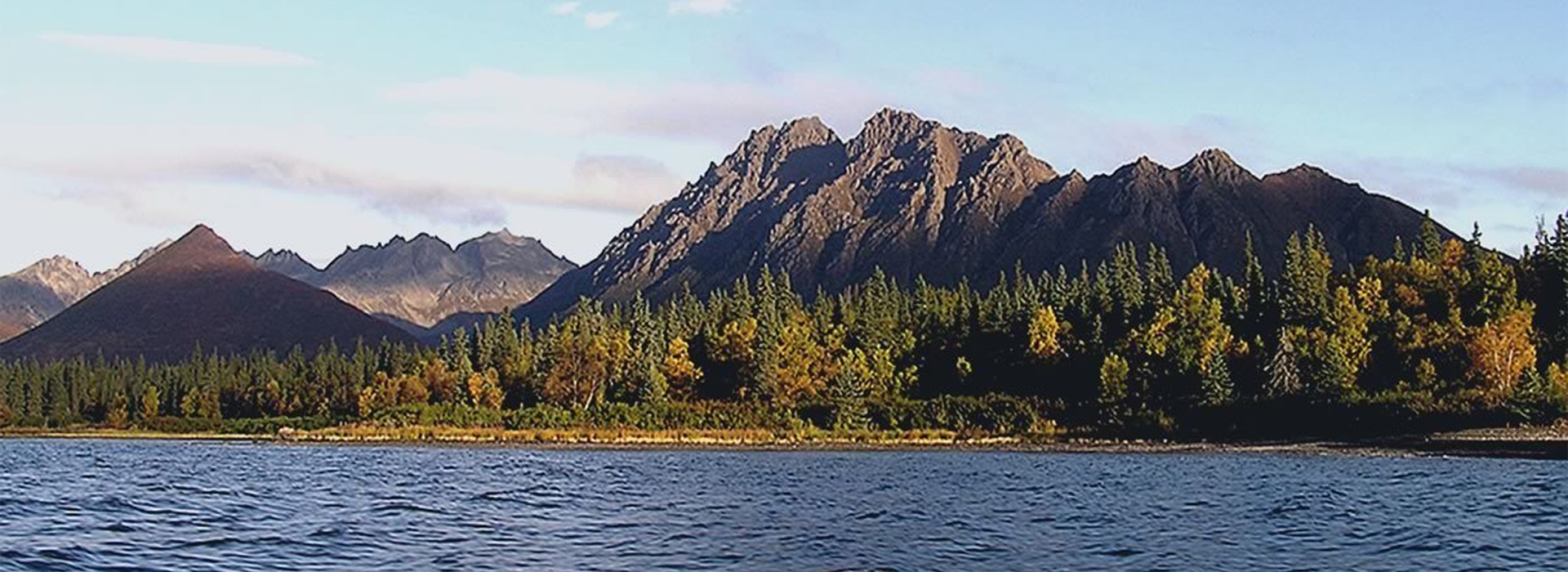
Alaskan-Yukon Moose Hunts
The non-resident moose season is open from the 5th to the 15th of September; it is an 11-day hunt. Primary hunting techniques are spot and stalk, calling and raking the brush in the swamps and marshes.
Our moose hunts are operated out of remote tent camps in Wood-Tikchik State Park, north of Dillingham, AK. Most of the hunting will be done out of boats on lakes and the Nushagak river in real Alaskan wilderness.
We provide both guided and unguided camps for moose hunting.
In order to do an unguided moose hunt, you need a minimum of 3 hunters in your group. All hunters must have a GPS and an external frame pack.
Nushagak Guides provides full camps including tents, cots, pads, cook stove, cooking utensils, lanterns, game bags, food, boat, fuel and bush flights in and out of the field (hunters and game).
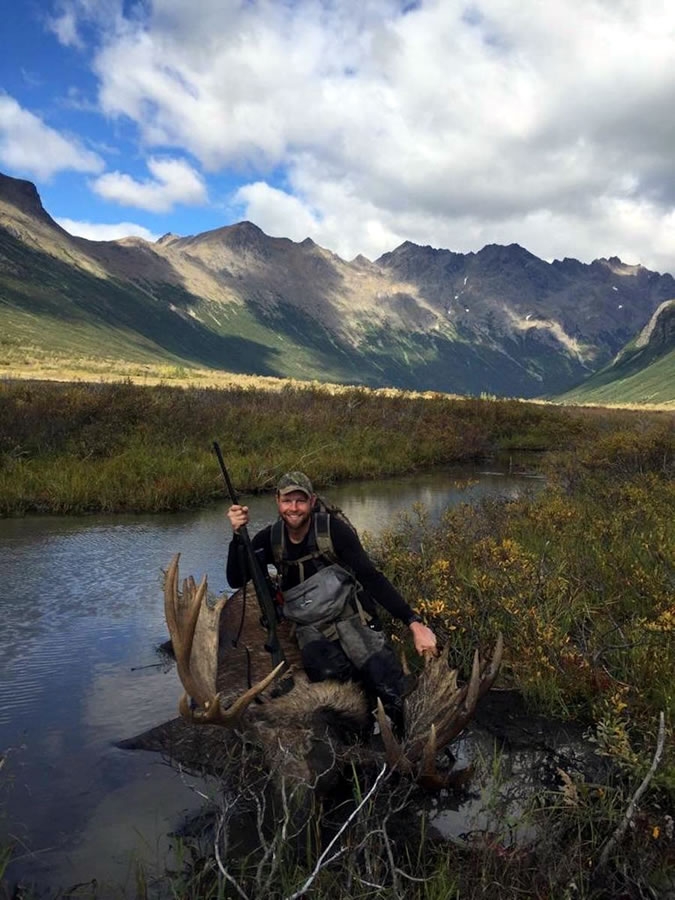
License, Fees, and Regulations
Hunters need to purchase their own commercial flight into Dillingham, plus moose tag ($800), hunting license ($170), and 14 day fishing license ($50). You may also want to purchase a wolf tag (free). The hunter is also responsible for shipping game back to the states. This usually runs about $500.00 per animal.
The Alaska Department of Fish and Game requires nonresidents to view the Moose Hunter Orientation videos on field judging and butchering. These are available on the ADF&G website. After viewing the video, you will need to contact the Dillingham ADF&G office (907) 842-2334 to obtain your certification card.
Moose Hunting Additional Information
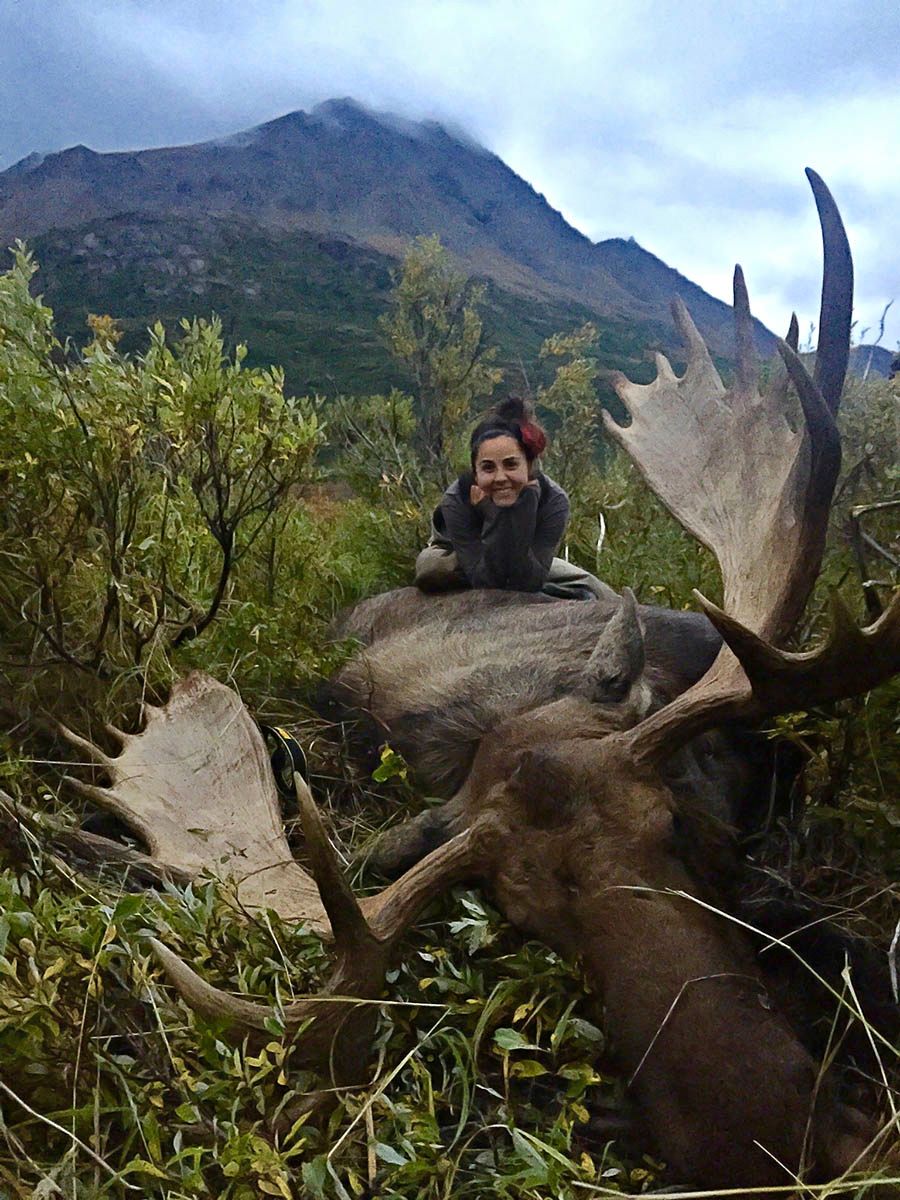
Unguided Moose Hunt: $10,500
- To fly the moose out of the field - $1500
- These prices do not include tags or airfare to Dillingham.
- Bush flight is included.
- 11-Day Hunt
Guided Moose Hunt: $34,000
- 1 hunter x 1 guide
- Sept 5th - 15th (11 days)
Guided Moose Hunt: $22,000 per person
- 2 hunters x 1 guide
- Sept 5th - 15th (10 days)
Book Your Moose Hunt Today
Combo Moose & Brown Bear Hunting Adventure
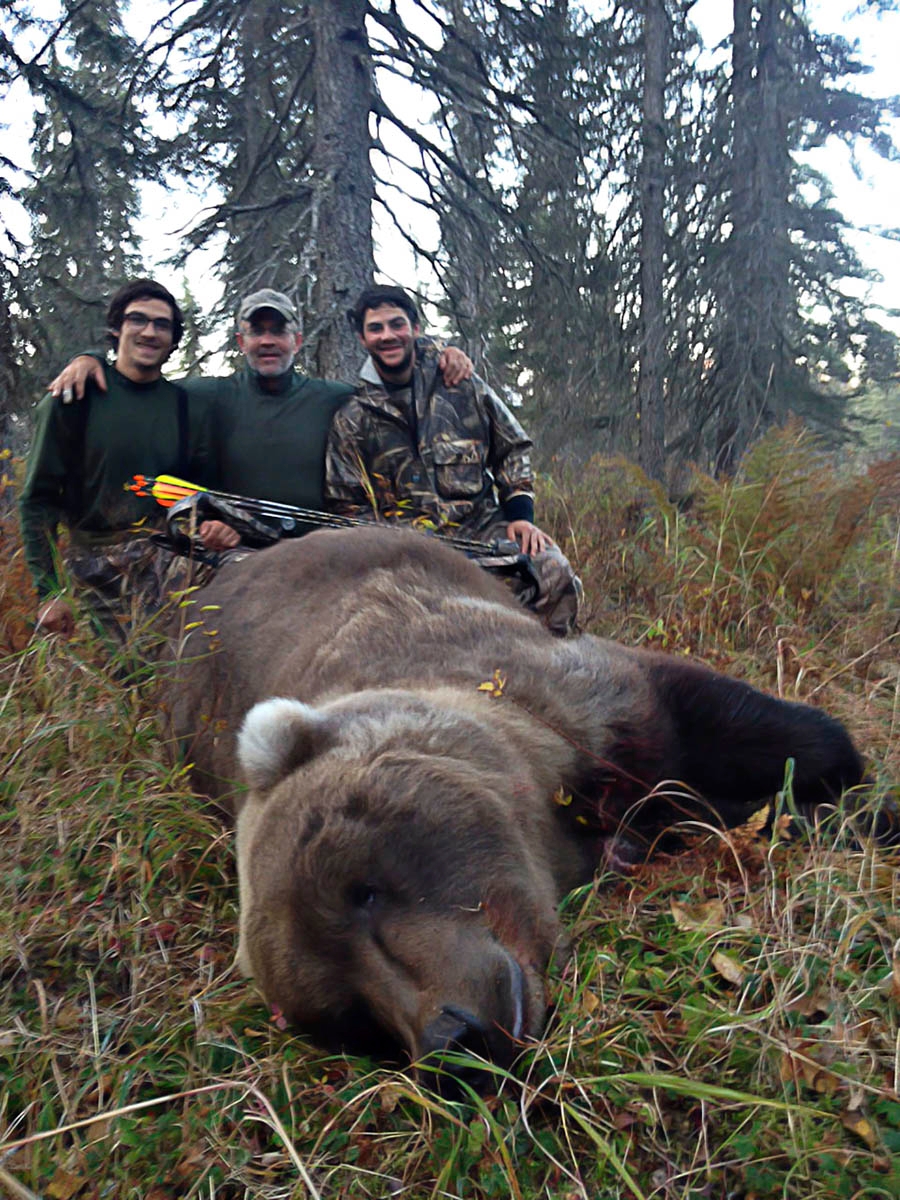
Combo Moose & Brown Bear: $38,500
Early September is also Moose season. We offer a great Alaska hunting adventure with a combination Brown Bear and Yukon Moose hunt.
- Sept 5th - 20th (15 days)
Read More About Fall Bear Hunts
Alaska Moose Hunting Gallery
1 - 36 of 96
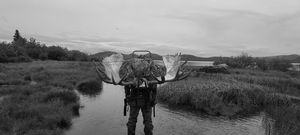
2024 Photos & Text Copyright - © Nushagak Guides Website by 3plains.com
Back To Top

Moose Hunting Alaska is an amazing trophy hunting experience. The Alaska/Yukon Moose is truly the largest of the Moose subspecies. The areas we are now hunting moose has the genetics for world class trophies as well, and the opportunities are high to harvest an animal in the 60 inches and higher. Some are non-typical and so unique. Back in the 1950’s the Alaskan fish and game department had transported moose down into unit 6 from the Kenia Peninsula and have done incredibly well even with all the brown bears and wolfs! If you look at the record books you will notice that peninsula moose are the highest percentage of all the moose records recorded.
Recommended Weapons When Moose Hunting in Alaska

Recommended weapons when Moose Hunting in Alaska is completely up to you whether it is a rifle or archery equipment. It is important to hunt with the right weapon for your Moose Hunting Trip. I recommend at a minimum a .300, .338, .375, or a .416 caliber weapon. The most important thing is that you have chosen a weapon that you are MOST COMFORTABLE and PROFICIENT WITH. Shot placement is particularly important on a Moose Hunt. Ideally, we try to get within 100 to 200 yards of our target and no further. You need a good quality, low power scope, because in some situations we are relatively close to the Moose. If you are a bow hunter, then I suggest a draw weight no less than 65 pounds. If we are also hunting dangerous game, then we want you to have the heaviest arrow possible for your bow so you get the highest kinetic energy and still shoot proficiently. Your shots will be from ten to twenty-five yards while archery hunting as your Moose Hunting Guide will also be a season archery hunter.
Gear List When Moose Hunting in Alaska September Through November

Moose Hunting in Alaska during September through November it is recommended to have Warm hat and gloves, light gloves, sun glasses, sun screen, ChapStick, light and medium weight long underwear, rain gear, light wool pants or Gortex pants/bibs, warm coat, underwear, sweater, hunting shirts, wool blend socks pair for each day, hip boots or light chest waders/hiking boots/camp shoes, (spare shoe laces), toothbrush and personal hygiene supplies, (no shower at spike camp, River only) lighter, headlamp, flashlight, camera, backpack water bottle, sleeping bag, sleeping pad, skinning knife, journal, novel to read, weapon of choice, hunting license, tags game bags, bug dope.
Alaska Moose Hunting Temperatures will start out in the 40–50-degree range in September then proceed to cool off as we get into November where it can get down into the lower 20-degree range. It does not really get colder than that however that wind will make it feel like it is down in the teens. Late October a pair of mittens would be smart to have and a few hand warmers.
Guided Alaskan Moose Hunting Package Pricing

Guided Alaskan Moose Hunting Dates start September 20th-30th and October 1st-10th. This is a 10-day hunt however, you must realize that in Alaska we cannot hunt on the day we fly, therefore you will be out for eleven days possibly twelve if we cannot get to you due to weather on that 11th day. You start hunting the day after you arrive at spike camp.
10-day Moose Hunt includes travel to and from hunting lodge , professional licensed guide, packer, camp and all the food/gear for that camp for only $28,500.00.
Non-Hunter Alaskan Moose Hunting Companion or guest are always welcome and can be added to your hunt for $5,000.00.
5% Sales Tax Will Be Calculated and Added to Your Final Bill
Hunting Licenses , Fees and Tags are not included in the package prices listed above. All Moose hunters are required to purchase a Nonresident hunting license: $160.00. You will also be required to purchase a Nonresident Locking Moose tag for $800.00 or a Nonresident Alien Locking Moose tag for $1,000.00.
Additional Big Game animals that can be added to your hunt include:
Brown Bear Hunt
Mountain Goat Hunt
Black Bear Hunt
Wolves are huntable in the fall and in the spring, but the season ends April 30th. The locking tag is only $60.00. No charge if harvested, just tip your guide in the field for taking the time of calling it in, stalking and skinning.
Moose Hunting Contact Form
Thanks for submitting!
Moose Hunting Alaska
Moose Hunts in Alaska (US)
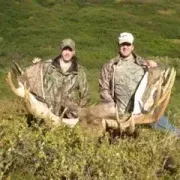

833-907-HUNT

Which Alaska Moose Hunt is Right Hunt For You?
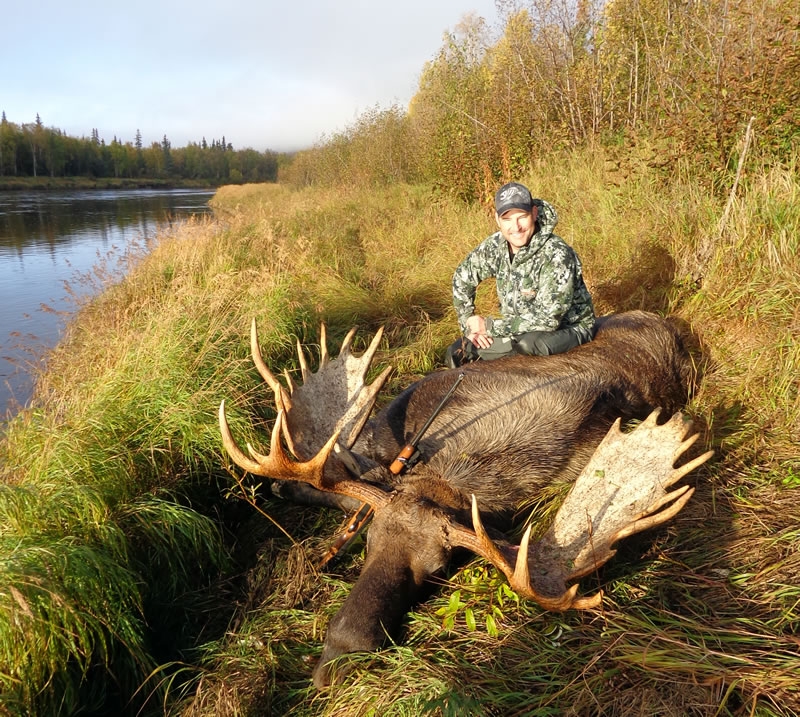
Self Guided Fixed Camp Moose Hunt
We offer three different types of self-guided hunts. Our most popular unguided moose hunt is our fixed-camp hunt. We drop you off on a stretch of river where we can take off and land with a full load. You set up your camp and hunt from that spot with a boat and motor. You can realistically hunt approximately a five-mile radius from that spot. There are a lot of oxbow lakes and sloughs off the river that are excellent hunting, and water is always close, making your packing much easier than carrying moose meat out long distances on your back. What makes this hunt popular is that you are in one spot long enough to find where the moose are frequenting and spend time hunting and calling them and figuring out their patterns. You also only have to set camp up one time. You can hunt until dark every night and come back to a comfortable camp. You can also leave camp at daylight without having to break down camp before you leave. The most important advantage is that we can land there during your hunt and pick up your moose. That is what we are famous for. Our service and ability to do more than just drop you off and pick you up.
SELF-GUIDED MOOSE HUNTS
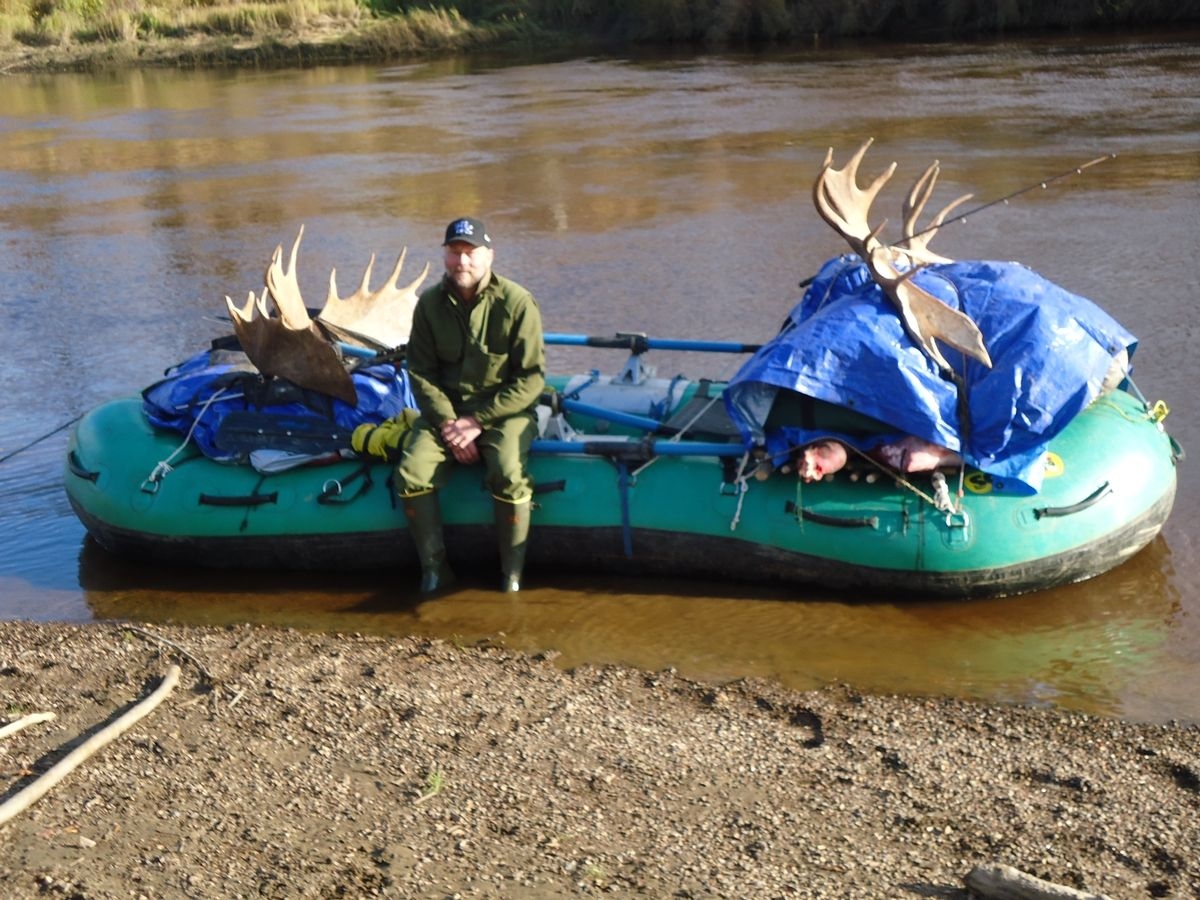
Self-Guided Float Moose Hunts
The second type of hunt we offer is a float hunt. Many people insist on a float hunt. A float hunt starts at one point and ends at a designated point downriver. Between the two points, we are unable to land and check on you. The advantages of a float hunt are that you are able to hunt much more area and sometimes an area that is more remote and less hunted. The disadvantages are that you have to set up and breakdown camp several times, usually in the dark, and every time you stop, you must unload your moose from the raft and hang it up. We are not able to land and take out your moose when you kill it. You must haul it with you for the entire float, hanging it up every night. Moose floats are 60-120 river miles. Floats can be very rewarding, but you must be able to stop and hunt for a couple of days when you see good moose signs, not just float all the time, hoping to float up on a moose and kill it from the raft. But if you want to hunt this way, you must break camp in the dark and be floating in daylight; then float for only a couple of hours, camp during the day, and start floating again about 2 hrs. before dark and float until it’s too dark to shoot. Then set up camp in the dark. This is an excellent way to hunt, but it is not for everyone as it can be very physically challenging. We are happy to book whichever type of hunt you like and would be happy to discuss the pros and cons of both with you. These hunts are based on a minimum of two people and are on an 11-day schedule, with day 1 and day 11 being fly-in/out of the bush days and 9 full days of hunting.
Self Guided Moose Hunting Packages
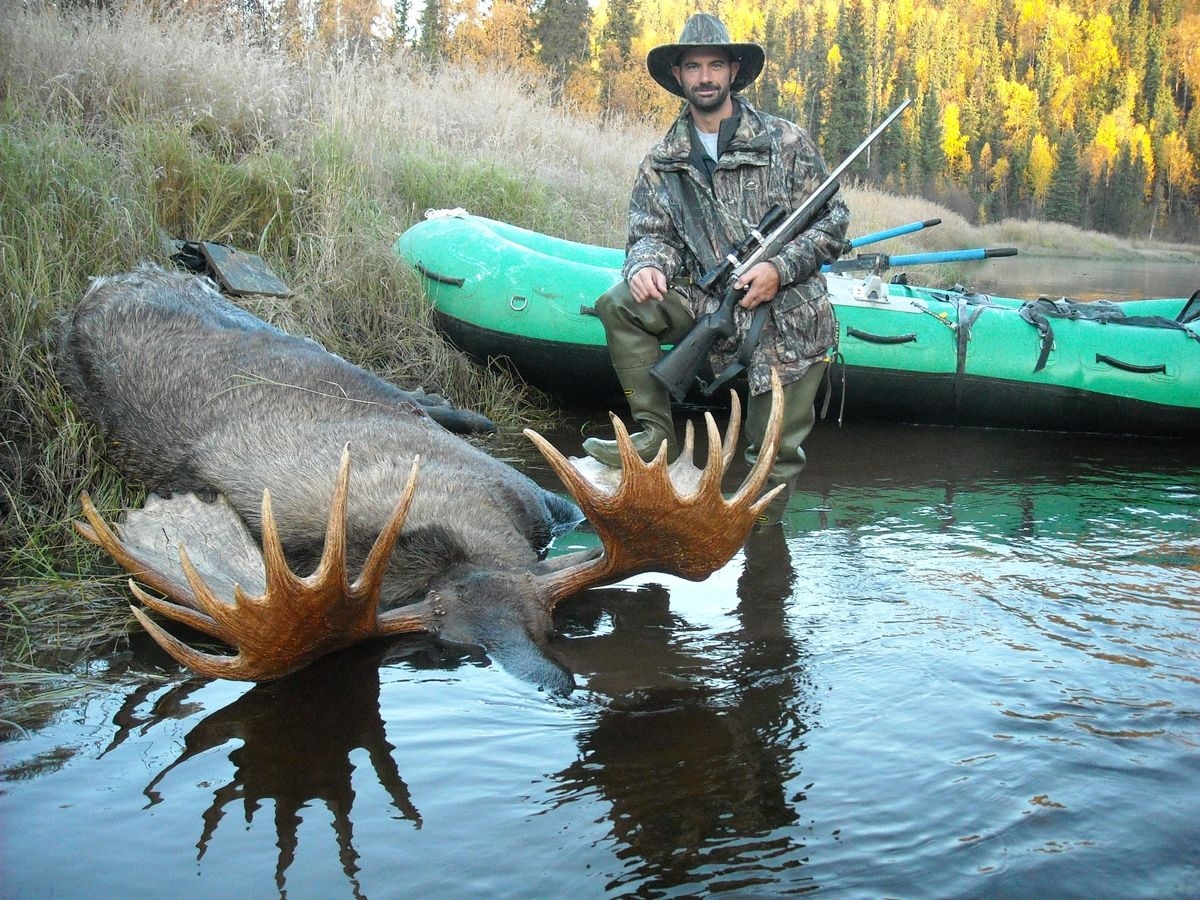
Self-Guided Extreme Float Hunt
Willow Air is doing a limited number of Extreme float moose hunts. Our normal float hunts are in very good areas, and by offering an Extreme float, I do not want anyone to get the idea that our normal floats are not remote. For the most part, they are just as productive, if not more productive, than our Extreme floats. What makes these Extreme floats different is they are extremely long float that requires two extra days to complete. All floats are much harder than our boat and motor fixed camp hunts due to the fact you are constantly moving camp, and you have to get to a pickup point before we can pick up your moose. This Extreme hunt is even more difficult. You might experience very low water levels that require unloading a raft to get through some low spots, plus it is just an extremely long float that requires extra days to complete. Either way, you must be in good physical condition for this hunt and be able to work hard. These hunts have been very productive, with around an 80% success rate. All our normal hunts are 11 days with 9 days of hunting, but these extreme hunts are a couple of days longer due to the logistics of these locations. When you get closer to your pickup point, you could see someone, but by then, you should have your moose and be done hunting. This is truly one of, if not the best, self-guided moose hunts in Alaska, but with the remoteness and the logistics of getting in and out, it is a very expensive area for us to do, especially if we keep the hunters to a minimum. There are also black bears, wolves, and wolverines in the area.
REQUEST MORE INFORMATION

EPIC ALASKA
Hunting. trapping. exploring. adventure..
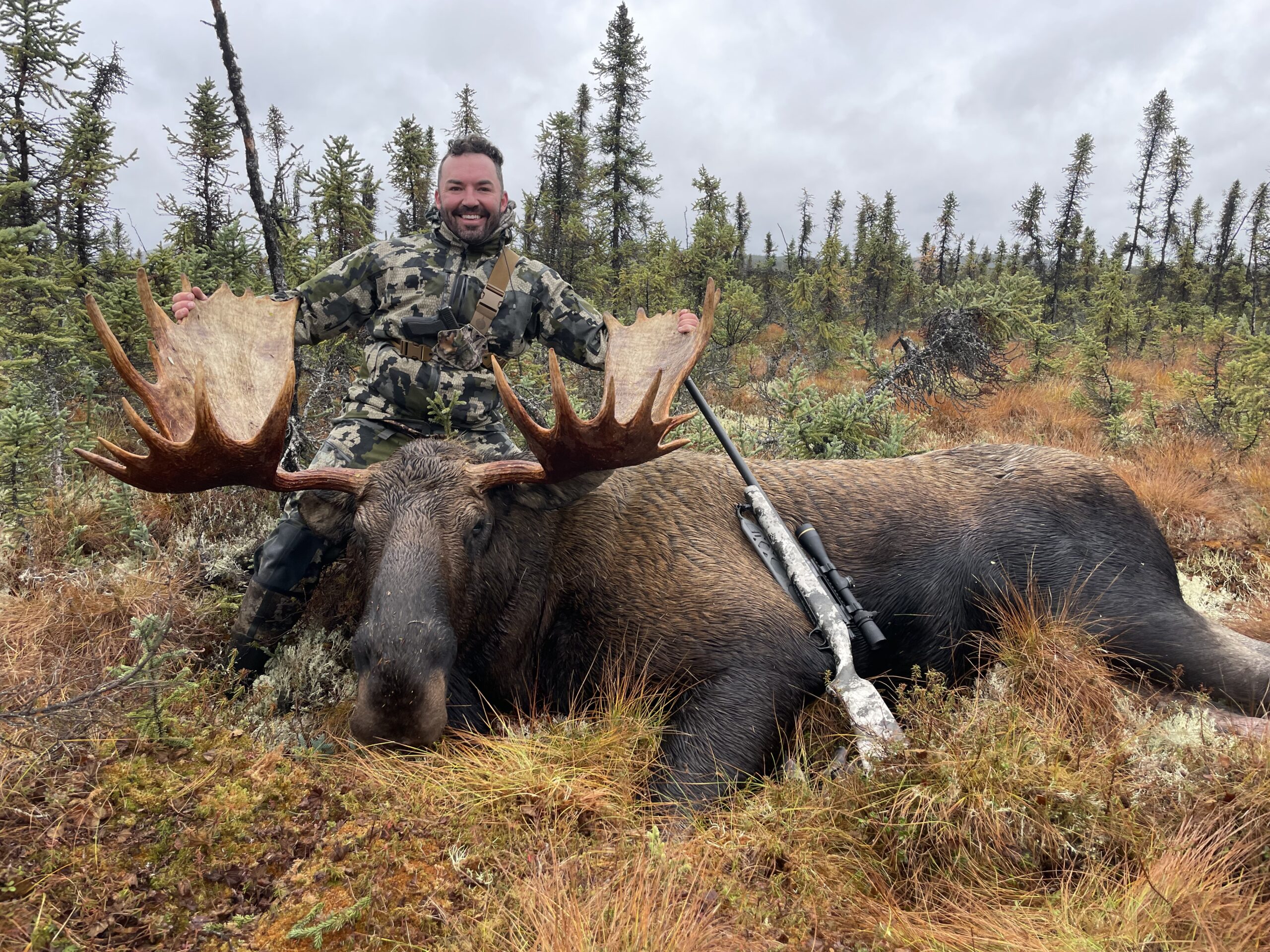
ABOUT EPIC ALASKA
Epic Alaska offers Unguided / Self Guided / DIY Moose hunting trips that target Yukon Moose in remote Interior Alaska.
If you are interested in a Guided Moose or Grizzly Bear hunt, we will refer you to a Registered Guide that we will work with to plan your hunting trip.
Winter Trapping and Snowmobile Tours are offered during the winter months.
Epic Alaska is a licensed Alaskan Big Game Transporter and Class-A Assistant Guide that is owned and operated by Jesse Grady who lives, hunts and has explored remote Interior Alaska and the Innoko River for over 30 years.
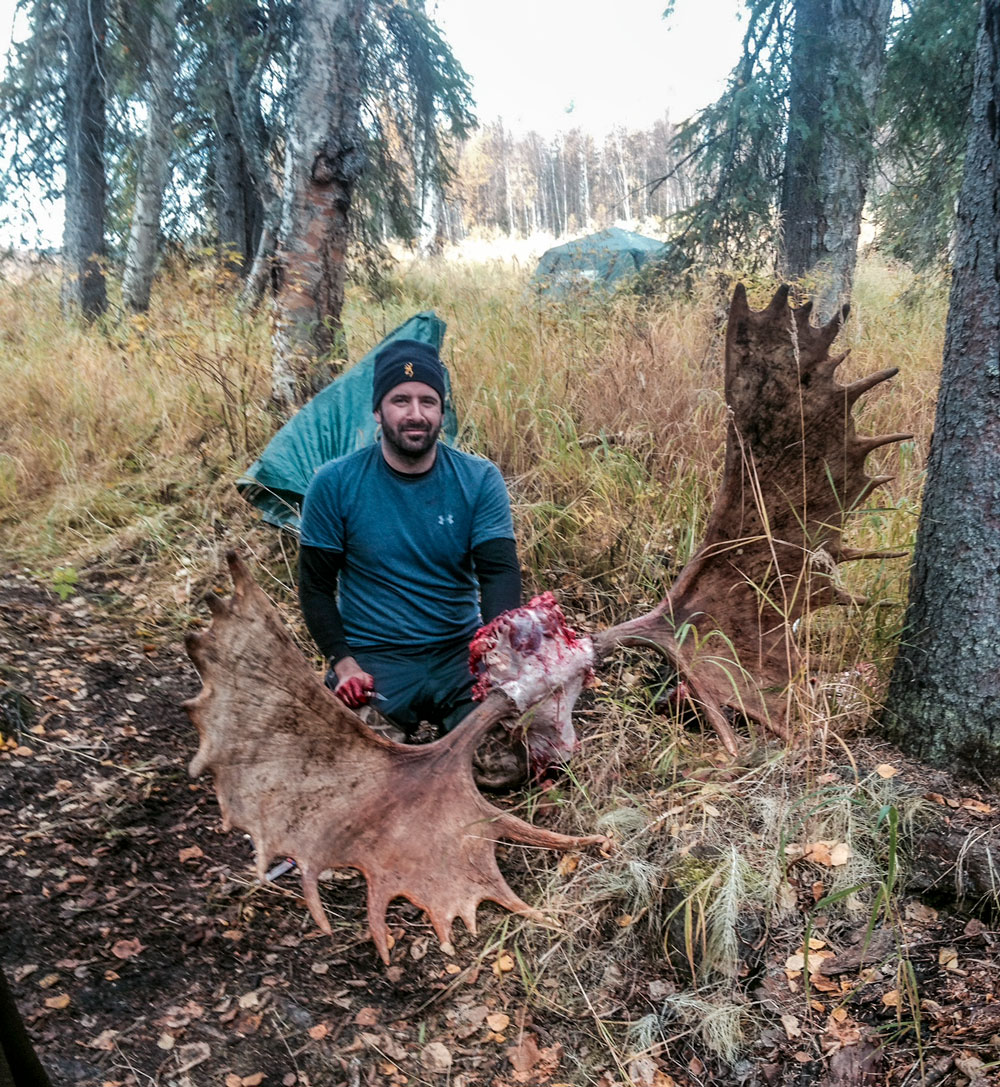
Plan your Epic Alaska Adventure
We work on a first come, first served basis and are only limited to what you would like to experience and how long you want to spend out in our Epic Alaska wilderness.
- All content
- Rural Alaska
- Crime & Courts
- Alaska Legislature
- ADN Politics Podcast
- National Opinions
- Letters to the Editor
- Nation/World
- Film and TV
- Outdoors/Adventure
- High School Sports
- UAA Athletics
- Food and Drink
- Visual Stories
- Alaska Journal of Commerce (Opens in new window)
- The Arctic Sounder
- The Bristol Bay Times
- Legal Notices (Opens in new window)
- Peak 2 Peak Events (Opens in new window)
- Educator of the Year (Opens in new window)
- Celebrating Nurses (Opens in new window)
- Top 40 Under 40 (Opens in new window)
- Alaska Spelling Bee (Opens in new window)
- Alaska Craft Brew Festival
- Best of Alaska
- Spring Career Fair (Opens in new window)
- Achievement in Business
- Youth Summit Awards
- Puffin Charter Giveaway
- White Raven Photo Contest - Voting
- Teacher of the Month
- 2024 Alaska Summer Camps Guide (Opens in new window)
- 2024 Graduation (Opens in new window)
- Alaska Visitors Guide 2023 (Opens in new window)
- 2023 Best of Alaska (Opens in new window)
- Alaska Health Care (Opens in new window)
- Merry Merchant Munch (Opens in new window)
- On the Move AK (Opens in new window)
- Senior Living in Alaska (Opens in new window)
- Youth Summit Awards (Opens in new window)
- Alaska Visitors Guide
- ADN Store (Opens in new window)
- Classifieds (Opens in new window)
- Jobs (Opens in new window)
- Place an Ad (Opens in new window)
- Customer Service
- Sponsored Content
- Real Estate/Open Houses (Opens in new window)
What researchers hope to learn from a Siberian tiger taking its final rest at Alaska’s Museum of the North
Tiger siblings Korol and Kunali relax in the snow at the Alaska Zoo in Anchorage. After each tiger died, zoo officials donated them to the UA Museum of the North in Fairbanks, where they are available for scientific research and outreach. (Photo courtesy of the Alaska Zoo)
It’s a safe bet that Aren Gunderson’s Toyota Tundra is the only one in Fairbanks that has had its bed filled with a Siberian tiger.
Gunderson, who manages the mammal collection at the University of Alaska Museum of the North, recently accepted a dead, frozen, 500-pound former resident of the Alaska Zoo in Anchorage outside the Fairbanks museum recently.
“It filled the 7-foot truck bed,” he said.
What was Gunderson doing with a frozen tiger?
After it thawed, he and museum co-workers Marissa Breslin and Jessica Cornelius skinned the animal and then removed most of its flesh from the bones.
They dried the skin with salt to prepare it for professional tanning. Beetle larvae are now at work defleshing the bones. Like Gunderson, they are laboring to provide answers to future questions.
For example, a researcher might walk into the museum with the bone of a scimitar-toothed cat that thawed out of a northern riverbank. Those giant cats roamed Alaska thousands of years ago and have a skeletal structure like a tiger’s.
Among a number of potential research possibilities, having all the labeled bones of Kunali might help a scientist determine which bone of an extinct scimitar cat or American lion someone has found in Alaska.
Aren Gunderson of the UA Museum of the North inspects the back paw of a Siberian tiger donated recently by officials of the Alaska Zoo in Anchorage after the tiger died at age 19. (Photo by Ned Rozell)
“Having the whole large cat skeleton gives us a reference for species IDs and fragmentary parts,” Gunderson said. “We preserve the skin and skeleton as parts we can loan for science and education purposes.”
Kunali died at age 19 at the Alaska Zoo in Anchorage on March 13. A zoo official drove the tiger carcass up the Parks Highway to UAF, where Gunderson slid it into his pickup bed and then transferred it into the museum with the help of a chain hoist.
Gunderson waited for the tiger to thaw on a stainless necropsy table. He then removed the hide and prepared the tiger’s bones and some tissue samples to be part of the museum’s extensive research collection.
Kunali was not the first Siberian tiger Gunderson had encountered in his job. He worked on Kunali’s brother Korol, another gift from the Alaska Zoo, last year. Though Gunderson mostly processes smaller mammals, such as dozens of marmots each year, he has also prepared and preserved camels, flying foxes, sloths and other animals not found today in Alaska.
“I never thought I’d get to skin two tigers,” said Gunderson, who would be a good partner to have on a moose hunt along with his kitchen knives and skinning blades. “It’s probably the most exotic, coolest thing I’ve done in my career.”
The Siberian tiger, also known as the Amur tiger, is one of six subspecies of tiger. All of them are considered endangered by the International Union for the Conservation of Nature. There are fewer than 500 Siberian tigers left in the wild; there are probably more of them alive today in zoos.
A Siberian tiger walks in the wilds of Siberia. (Remote camera photo courtesy of the Ministry of the Russian Federation for the Development of the Far East and Arctic)
The giant felines live in eastern Russia’s birch forests at the same latitudes as Alaska, as well as in China and North Korea. The largest weigh more than 600 pounds, and they are one of few cat species comfortable in the snow.
Kunali and his sibling Korol both came to the Alaska Zoo from a zoo in Syracuse, New York, in 2008. They both lived for more than a decade in Anchorage.
Once its bones are cleaned and each labeled with a unique catalog number, Kunali’s skeleton will be among the tens of thousands housed at the UA Museum of the North. Kunali’s bones could someday join displays of a bowhead whale and a few extinct hadrosaurs that greet visitors near the museum entrance.
“Lots of people don’t get to see a tiger,” Gunderson said. “(Kunali) gives people a reference for how large of an animal it is. It also provides a really impressive example of biodiversity.”
Ned Rozell | Alaska Science
Ned Rozell is a science writer with the Geophysical Institute at the University of Alaska Fairbanks.

IMAGES
VIDEO
COMMENTS
Moose Hunts. Alaska moose hunting is the ultimate adventure. The sight of a mature animal raking its antlers only thirty yards away or hearing a 1500 pound bull crashing through the brush responding to your call is an unforgettable experience. The Moose, Alces alces, is the largest member of the deer family, we hunt the Alaska-Yukon race, Alces ...
Join Alaska Elite Outfitters on a Guided Alaska Moose Hunt experience in the Alaskan wilderness. Offering the only 15 day Moose/Brown Bear Combo hunt. Skip to content (218) 434-0068 (907) 464-6165; ... All Self-guided trips include lodging, food, bedding, shower facilities, rods/reels, freezers and
Our Alaska guided moose hunting trips is especially good because of our very limited harvest and the geographic location of the area. Guided moose hunting Alaska come from the flats where they have spent their summer and go up into the high country to rut. We hunt the passes on the edge of the high country and catch the bulls as they travel ...
The Alaska-Yukon Moose is one of the most desirable trophies of all the Big Game species in Alaska. With up to 80 inches of horn and weighing up to 1,700 lbs, nothing is more magnificent than a giant bull moose. ... Hunting Trips. Big game trophy hunts in Talkeetna. Stephan Lake Talkeetna Adventure Lodge. Stephan Lake Lodge is a remote ...
6-16 Sep - 11 day, 1 hunter-1 guide, Alaska Yukon Moose (Raft hunt) $24,900.00 *INQUIRE*. 1-10 December - 10 day, Alaska Yukon Moose (Snowmobile hunt) $15,900.00 per hunter. *INQUIRE*. My guided Alaska moose hunts are multi-species hunts - if you choose. You can harvest any other animal that is in season, and you possess the tags for, at no ...
Don't let moose hunting season pass you by without checking off that moose hunting trip from your bucket list. With their great size, awesome power, and flavorful meat, moose are valuable to a lot of hunters above all other big game. Venture into Alaska's virgin, unspoiled territory when you join us at River Rock Lodge and experience the ...
A few Snapshots from our Moose Hunts. Would you like more information about this hunt? Reach out at: (907)-803-3552 OR (907)-616-1042 or. We specialize in high quality moose and grizzly hunts in Alaska. We pride ourselves in providing "Personalized, Quality Hunts with Integrity" in Alaska.
Guided: 1×1, 10-days, $30,000-$35,000, with $10,000 trophy fee if grizzly is taken, $5,000 if caribou is taken. All prices subject to change. All hunts listed do not include transportation to nearest Alaskan airport, hunting license, tags, gratuities, or shipping of trophy from Alaska to your home.
Moose & Brown Bear Combo 10 day 1x1: $24,500. NO TROPHY FEES! NO HIDDEN FEES! Location: Unit 14, 16, 20. Hunting Dates: September 5-14 & Sept 16-25. Experience Alaska moose hunting with Alaska's Ultimate Trophy Hunting. Our guided trophy moose hunting trips take place in the shadows of 20,308 foot Mount Denali.
Guided Moose Hunts. Alaska Moose Hunting is a staple of adventure as well as table fare for most born and raised Alaskans. Large enough to feed whole families, yet they can be elusive to find. The Moose is a browser and lives on the saplings of the willow and occasionally feeding on water plants. In our Exclusive Use Area on the Alaska ...
How Much Does it cost for a moose hunt? The 2024 price of a fully outfitted, 10 day guided moose hunt is $22,500. For more information on rates, deposits and Combo hunt prices, check out the hunt prices page. Alaska Moose Hunting Season Moose hunting season is from September 1st to September 25th. The moose are rutting during this time.
Our Alaska-Yukon moose are one of our most sought-after trophies. This largest deer can weigh 800-1600 pounds on the hoof. Bolstering 55-65+" antler spread. A typical year for us has some hunters taking bulls of the 60" club, if they are patient and willing to work hard. Our hunt areas are mostly forested although the option of spiking out ...
The Alaska Moose Hunt . All our moose hunts take place during the rut in Alaska. The hunting period consists of a 21-day season in September, and hunts are 10 days long within that period. 1 x 1 or 2 x 1 guided hunts are available. The hunt will consist of a mix of spot & stalk and calling, depending on conditions.
Regardless of which route you choose, all hunters will need Alaska hunting licenses and harvest cards/ permits. Below are the costs for Non-residents. Current Alaska Department of Fish and Game fees are as follows: Non-Resident Annual Hunting: $160. Non-Resident Moose Big Game Locking Tag: $800.
Guided Moose Hunting Rates. Guided Non-Resident Alaska Yukon Moose, Black Bear & Wolf Hunts $31,900 each for 1 hunter to 1 Guide hunt for 12-days $27,700 each for 2 hunters to 1 Guide hunt for 12-days. Non-Resident License and Tag fees Moose tag @ $800 Brown/Grizzly Bear tag $1000 Black Bear tag $450. Tags for Wolves are not required in unit 19b.
Meat Harvest. Hunting moose in Alaska also provides a bountiful source of meat. Each year, hunters harvest over 7,000 of Alaska's estimated 175,000 moose. The substantial size of these animals translates to a significant amount of meat, often ranging between 500 and 700 pounds of edible meat per animal.
Combo Moose & Brown Bear: $38,500. Early September is also Moose season. We offer a great Alaska hunting adventure with a combination Brown Bear and Yukon Moose hunt. Sept 5th - 20th (15 days) These prices do not include tags or airfare to Dillingham. Bush flight is included. Read More About Fall Bear Hunts.
We were 75% successful last season, and that has been consistent with our average moose hunting success rates. 4.2 ⭐ Reviews (15)Willow Air offers safe, affordable self-guided fly-in Alaska moose hunting adventures in the remote Innoko Wildlife Refuge. Call 833-907-HUNT to book your hunt.
10-day Moose Hunt includes travel to and from hunting lodge, professional licensed guide, packer, camp and all the food/gear for that camp for only $28,500.00. Non-Hunter Alaskan Moose Hunting Companion or guest are always welcome and can be added to your hunt for $5,000.00. 5% Sales Tax Will Be Calculated and Added to Your Final Bill.
The state of Alaska allows for non-residents to hunt moose and black bear without a guide. Adventure Outfitters Alaska offers the most affordable moose hunting trips possible! We have an excellent success rate and can accommodate large groups. There is a 2 person minimum on these hunts. This hunt is "turn-key", meaning we provide transportation ...
Alaska/Yukon Moose Hunting in Alaska From $21,000 to $28,000. Alaska • Our Moose are known to be the largest moose in Alaska, we keep our camps small to provide you with the best chance of tagging the moose of a lifetime. A-Team Outfitting. Alaskan Yukon Moose Hunt - 11 Full Hunting Days - 1x1 Starting from $25,000.
These hunts have been very productive, with around an 80% success rate. All our normal hunts are 11 days with 9 days of hunting, but these extreme hunts are a couple of days longer due to the logistics of these locations. When you get closer to your pickup point, you could see someone, but by then, you should have your moose and be done hunting.
Epic Alaska offers Unguided / Self Guided / DIY Moose hunting trips that target Yukon Moose in remote Interior Alaska. If you are interested in a Guided Moose or Grizzly Bear hunt, we will refer you to a Registered Guide that we will work with to plan your hunting trip. Winter Trapping and Snowmobile Tours are offered during the winter months.
Gunderson, who manages the mammal collection at the University of Alaska Museum of the North, recently accepted a dead, frozen, 500-pound former resident of the Alaska Zoo in Anchorage outside the ...